LiG Metrology, Correlated Error, and the Integrity of the Global Surface Air-Temperature Record
Abstract
1. Introduction
2. Facilities and Methods
3. Results
3.1. LiG Thermometers: Resolution, Linearity, and Joule-Drift
3.1.1. Resolution
3.1.2. Linearity
3.1.3. Joule-Drift
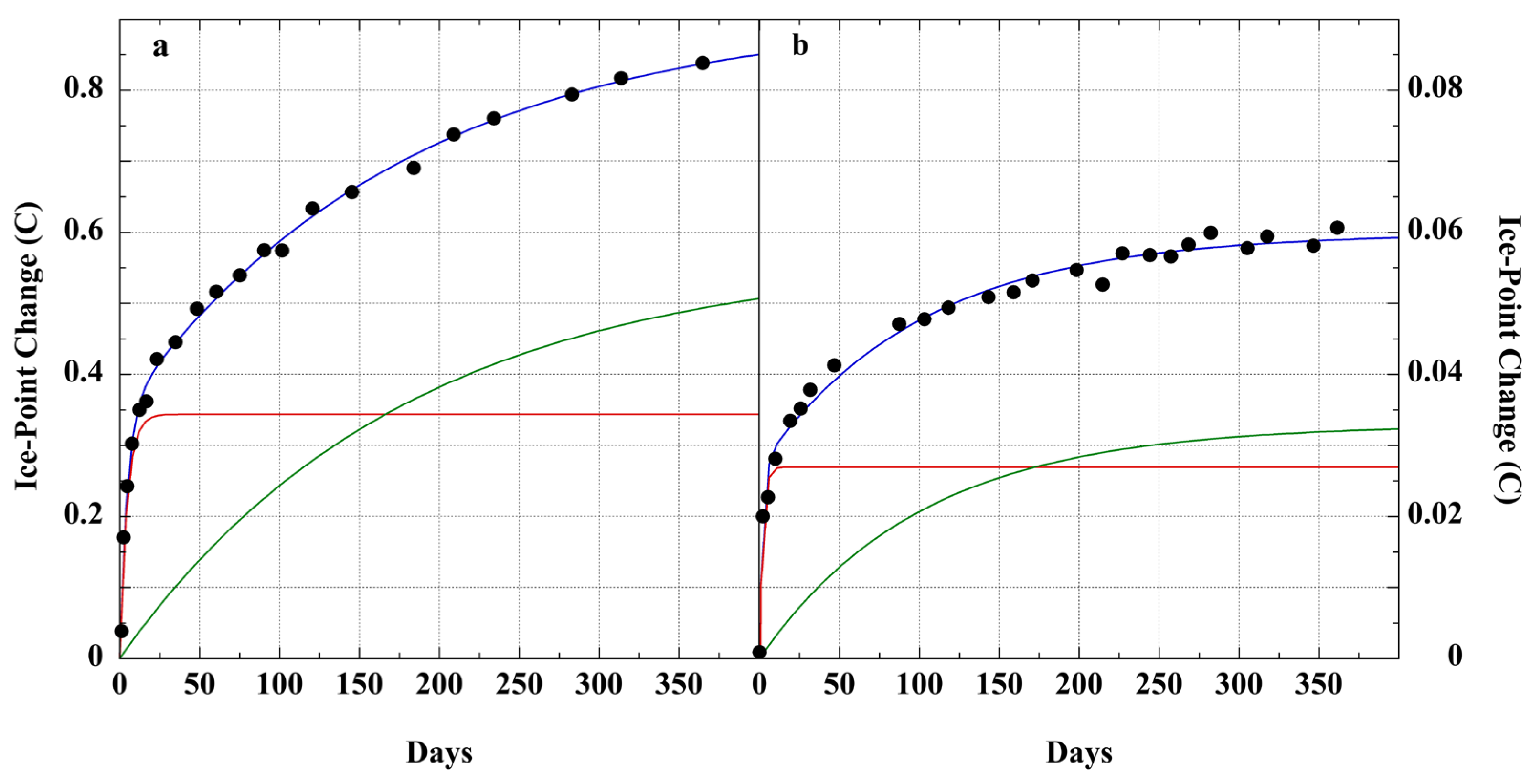
| Glass Type | SiO2 | Na2O | K2O | CaO | B2O3 | Al2O3 | PbO | Reference |
|---|---|---|---|---|---|---|---|---|
| Silica-lead a | 68 | 10 | 6 | 1 | --- | --- | 15 | [152] |
| Borosilicate a | 80 | 14 | --- | --- | 14 | 2 | --- | [152] |
| Corning 0041 | 50.1 | 6.6 | 1.5 | --- | --- | 1.9 | 39.9 | [155] |
| Corning 1720 b | 62 | 1 | --- | 8 | 5 | 17 | --- | [153] |
| Jena 59III c | 72 | 11 | --- | --- | 12 | 5 | --- | [156] |
| Thuringian d | 68.7 | 15.9 | 7.3 | 5.7 | --- | 2.1 e | --- | [144] |
| Kew f | 53.9 | 1.7 | 8.5 | 0.56 | --- | 0.48 | 34.5 | [157] |
| Kew g | 53 | 0.5 | 11.5 | --- | --- | 0.5 d | 34 | [158] |
3.2. Lead Glass
3.3. Thermometer Field Calibration and Measurement Error
3.3.1. De Bilt (Netherlands)
3.3.2. Plaine Morte Glacier (Swiss Alps)
3.3.3. HOBO Thermistors, Ottawa
3.3.4. Wire Thermocouples, SRNL
3.4. Sea-Surface Temperature
3.4.1. Context
3.4.2. Does Semivariogram Analysis Yield the SST Measurement Error Mean?
3.4.3. Are SST Measurement Errors Random?
Instrumental Calibration
The Difference of Normal Distributions
Bucket SSTs
Engine-Intake SSTs
- Brooks
- 2.
- WMO
- 3.
- Walden
- 4.
- Saur
3.4.4. Tsample and Ttrue
4. Discussion
4.1. Land-Surface Air Temperatures
4.2. Resolution Limits
4.3. Sea Surface
4.4. Global
4.5. Sensor-Transfer Functions
4.6. A Lower Limit of Uncertainty in the Global Averaged Surface Air Temperature to 2010
- The accuracy—the limit of detection of high-quality 1 °C/division mercury LiG thermometers;
- The resolution—the limit of visual repeatability of a temperature reading under ideal laboratory conditions;
- The non-linearity of LiG response to temperature;
- The land-station systematic field-measurement uncertainty from calibrations of well-sited and well-maintained sensors;
- The SST bucket, engine-intake, and bathythermograph uncertainties from calibrations by trained personnel aboard an ocean research vessel.
4.7. Joule-Drift
5. Conclusions
5.1. Major Findings
- The accuracy limit of LiG meteorological thermometers, 2σ = ±0.11 °C/°F, had been ignored;
- The laboratory lower-limit ideal of visual repeatability of LiG thermometer, 2σ = ±0.144 °C/°F, had been ignored;
- The published uncertainty of the 1900–1980 global average air-temperature anomaly record was less than the combined 2σ = ±0.432 °C laboratory ideal lower limit of resolution of high-quality LiG thermometers;
- Joule-drift of pre-1890 lead-glass or soft-glass thermometers had been ignored, but renders unreliable the early air-temperature record through the 19th century;
- Lead-glass meteorological thermometers were still manufactured and entering use in 1900;
- Land- and sea-surface temperatures had not been corrected for the non-linear response of LiG thermometers;
- Systematic measurement error produced by naturally ventilated land-surface air-temperature sensors is not random;
- Systematic land-surface air-temperature-measurement error is correlated across sensors;
- The semivariogram method does not reveal mean SST measurement error, but rather, half the mean difference in error, i.e., 0.5Δεµ;
- The mean error in SST measurements remains unknown (as does the marine wind measurement error mean);
- Bucket SST measurement error is typically not random;
- Engine-intake SST measurement error is not random;
- The distribution of ship SST measurement error varies with each trip, with the crew (and even with the watch), and between ships;
- Means of ship SST error distributions are themselves not randomly distributed;
- Turbulence caused by the ship (platform) itself generally obviates the correspondence of the measurement to the undisturbed state of surface waters. In-situ SST measurements that may be accurate, will nevertheless be physically incorrect.
5.2. Involve the ASPE
5.3. Final Conclusions
Supplementary Materials
Funding
Institutional Review Board Statement
Informed Consent Statement
Data Availability Statement
Acknowledgments
Conflicts of Interest
Abbreviations
| AGR | radar picket ship |
| ARGO | Array for Real-Time Geostrophic Oceanography |
| ASCII | American Standard Code for Information Interchange |
| BT | bathythermograph |
| CI | confidence interval |
| CRN | Climate Research Network |
| CRS | cotton region shelter |
| CTD | conductivity–temperature–depth |
| DER | destroyer escort |
| FWHM | full width at half maximum |
| GHCN | Global Historical Climatology Network |
| GISSTemp | Goddard Institute of Space Studies anomaly record |
| GSATA | global surface air-temperature anomaly |
| HadCRUT | UK Met Hadley Centre and University of East Anglia Climate Research Unit anomaly record. |
| ICOADS | International Comprehensive Ocean–Atmosphere Data Set |
| IPCC | Intergovernmental Panel on Climate Change |
| keV | kilo electron-Volt |
| KNMI | Koninklijk Nederlands Meteorologisch Instituut |
| LiG | liquid-in-glass |
| MAE | mixed alkali effect |
| MMTS | min–max temperature system |
| MSTS | Military Ship Transport Service |
| NBS | National Bureau of Standards |
| NCAR | National Center for Atmospheric Research |
| NIST | National Institute of Standards and Technology |
| NMAH | National Museum of American History |
| PRT | platinum resistance thermometer |
| PVC | polyvinyl chloride |
| RMS | root–mean–square |
| SEA | Sea Education Association |
| SST | sea-surface temperature |
| STD | salinity–temperature–depth |
| USHCN | United States Historical Climatology Network |
| VOS | voluntary observing ships |
| WMO | World Meteorological Organization |
| XRF | X-ray fluorescence |
References
- Ahlmann, H.W. The Present Climatic Fluctuation. Geogr. J. 1948, 112, 165–193. [Google Scholar] [CrossRef]
- Willett, H.C. Patterns of world weather changes. Eos Trans. Am. Geophys. Union 1948, 29, 803–809. [Google Scholar] [CrossRef]
- Mitchell, J.M., Jr. Recent Secular Changes of Global Temperature. Ann. N. Y. Acad. Sci. 1961, 95, 235–250. [Google Scholar] [CrossRef]
- Mitchell, J.M. On the Causes of Instrumentally Observed Secular Temperature Trends. J. Atmos. Sci. 1953, 10, 244–261. [Google Scholar] [CrossRef]
- Hubbard, K.G.; Lin, X.; Walter-Shea, E.A. The Effectiveness of the ASOS, MMTS, Gill, and CRS Air Temperature Radiation Shields. J. Atmos. Ocean. Technol. 2001, 18, 851–864. [Google Scholar] [CrossRef]
- Georges, C.; Kaser, G. Ventilated and unventilated air temperature measurements for glacier-climate studies on a tropical high mountain site. J. Geophys. Res. Atmos. 2002, 107, ACL 15-1–ACL 15-10. [Google Scholar] [CrossRef]
- Frank, P. Systematic Error in Climate Measurements: The global air temperature record. In Proceedings of the Role of Science in the Third Millennium, Singapore, 19–25 August 2016; pp. 337–351. [Google Scholar]
- Sparks, W.R. The Effect of Thermometer Screen Design on the Observed Temperature; Davis, D.A., Ed.; World Meteorological Organization: Geneva, Switzerland, 1972.
- Naylor, S. Thermometer screens and the geographies of uniformity in nineteenth-century meteorology. Notes Rec. R. Soc. J. Hist. Sci. 2019, 73, 203–221. [Google Scholar] [CrossRef]
- Jones, P. The reliability of global and hemispheric surface temperature records. Adv. Atmos. Sci. 2016, 33, 269–282. [Google Scholar] [CrossRef]
- Lenssen, N.J.L.; Schmidt, G.A.; Hansen, J.E.; Menne, M.J.; Persin, A.; Ruedy, R.; Zyss, D. Improvements in the GISTEMP Uncertainty Model. J. Geophys. Res. Atmos. 2019, 124, 6307–6326. [Google Scholar] [CrossRef]
- Morice, C.P.; Kennedy, J.J.; Rayner, N.A.; Winn, J.P.; Hogan, E.; Killick, R.E.; Dunn, R.J.H.; Osborn, T.J.; Jones, P.D.; Simpson, I.R. An Updated Assessment of Near-Surface Temperature Change From 1850: The HadCRUT5 Data Set. J. Geophys. Res. Atmos. 2021, 126, e2019JD032361. [Google Scholar] [CrossRef]
- Rohde, R.A.; Hausfather, Z. The Berkeley Earth Land/Ocean Temperature Record. Earth Syst. Sci. Data 2020, 12, 3469–3479. [Google Scholar] [CrossRef]
- Shackleton, N.J. Attainment of isotopic equilibrium between ocean water and the benthonic foraminifera genus Uvigerina: Isotopic changes in the ocean during the last glacial. In Proceedings of the Colloques Internationaux du Centre National de la Recherche Scientifique, Gif-Sur-Yvette, France, 5–9 June 1973; Volume 219, pp. 203–209. [Google Scholar]
- Schneider, S.H. On the Carbon Dioxide-Climate Confusion. J. Atmos. Sci. 1975, 32, 2060–2066. [Google Scholar] [CrossRef]
- Mitchell, J.M., Jr. Carbon Dioxide and Future Climate. EDS Environ. Data Serv. March 1977, 3–9. [Google Scholar] [CrossRef]
- Miles, M.K. Predicting temperature trend in the Northern Hemisphere to the year 2000. Nature 1978, 276, 356–359. [Google Scholar] [CrossRef]
- Charney, J.G.; Arakawa, A.; Baker, D.J.; Bolin, B.; Dickinson, R.E.; Goody, R.M.; Leith, C.E.; Stommel, H.M.; Wunsch, C.I. Carbon Dioxide and Climate: A Scientific Assessment; National Academy of Sciences: Washington, DC, USA, 1979; p. 18. [Google Scholar]
- Hansen, J.; Lebedeff, S. Global Trends of Measured Surface Air Temperature. J. Geophys. Res. 1987, 92, 13345–13372. [Google Scholar] [CrossRef]
- Hansen, J. Statement of Dr. James Hansen, Director, NASA Goddard Institute for Space Studies. Available online: http://image.guardian.co.uk/sys-files/Environment/documents/2008/06/23/ClimateChangeHearing1988.pdf (accessed on 4 June 2021).
- Hansen, J.; Fung, I.; Lacis, A.; Rind, D.; Lebedeff, S.; Ruedy, R.; Russell, G.; Stone, P. Global Climate Changes as Forecast by Goddard Institute for Space Studies Three-Dimensional Model. J. Geophys. Res. 1988, 93, 9341–9364. [Google Scholar] [CrossRef]
- IPCC. Climate Change: The IPCC Scientific Assessment. In Contribution of Working Group I to the First Assessment Report of the Intergovernmental Panel on Climate Change; Houghton, J.T., Jenkins, G.J., Ephraums, J.J., Eds.; Cambridge University: Cambridge, UK, 1990; p. 365. [Google Scholar]
- Hansen, J.; Wilson, H. Commentary on the significance of global temperature records. Clim. Chang. 1993, 25, 185–191. [Google Scholar] [CrossRef]
- IPCC. Summary for Policymakers. In Climate Change 2021: The Physical Science Basis—Contribution of Working Group I to the Sixth Assessment Report of the Intergovernmental Panel on Climate Change; Masson-Delmotte, V., Zhai, P., Pirani, A., Connors, S.L., Péan, C., Berger, S., Caud, N., Chen, Y., Goldfarb, L., Gomis, M.I., et al., Eds.; Cambridge University Press: Cambridge, UK; New York, NY, USA, 2021; pp. 3–32. [Google Scholar]
- Alexander, M.D.; MacQuarrie, K.T.B. Toward a Standard Thermistor Calibration Method: Data Correction Spreadsheets. Groundw. Monit. Remediat. 2005, 25, 75–81. [Google Scholar] [CrossRef]
- Stillman, R. Downstream from calibration. In Proceedings of the IEE Colloquium on Contribution of Instrument Calibration to Product Quality—Part 2, London, UK, 25 April 1995; pp. 9/1–9/2. [Google Scholar]
- Barcelo-Ordinas, J.M.; Doudou, M.; Garcia-Vidal, J.; Badache, N. Self-calibration methods for uncontrolled environments in sensor networks: A reference survey. Ad Hoc Netw. 2019, 88, 142–159. [Google Scholar] [CrossRef]
- Tellinghuisen, J. Calibration: Detection, Quantification, and Confidence Limits Are (Almost) Exact When the Data Variance Function Is Known. Anal. Chem. 2019, 91, 8715–8722. [Google Scholar] [CrossRef]
- Abernethy, R.B.; Benedict, R.P.; Dowdell, R.B. ASME Measurement Uncertainty. J. Fluids Eng. 1985, 107, 161–164. [Google Scholar] [CrossRef]
- Vasquez, V.R.; Whiting, W.B. Accounting for Both Random Errors and Systematic Errors in Uncertainty Propagation Analysis of Computer Models Involving Experimental Measurements with Monte Carlo Methods. Risk Anal. 2006, 25, 1669–1681. [Google Scholar] [CrossRef] [PubMed]
- Hubbard, K.G.; Lin, X. Realtime data filtering models for air temperature measurements. Geophys. Res. Lett. 2002, 29, 67-1–67-4. [Google Scholar] [CrossRef]
- Lin, X.; Hubbard, K.G.; Baker, C.B. Surface Air Temperature Records Biased by Snow-Covered Surface. Int. J. Climatol. 2005, 25, 1223–1236. [Google Scholar] [CrossRef]
- MacHattie, L.B. Radiation Screens for Air Temperature Measurement. Ecology 1965, 46, 533–538. [Google Scholar] [CrossRef]
- Huband, N.D.S.; King, S.C.; Huxley, M.W.; Butler, D.R. The performance of a thermometer screen on an automatic weather station. Agric. For. Meteorol. 1984, 33, 249–258. [Google Scholar] [CrossRef]
- Erell, E.; Leal, V.T.; Maldonado, E. Measurement of air temperature in the presence of a large radiant flux: An assessment of passively ventilated thermometer screens. Bound.-Layer Meteorol. 2005, 114, 205–231. [Google Scholar] [CrossRef]
- Huwald, H.; Higgins, C.W.; Boldi, M.-O.; Bou-Zeid, E.; Lehning, M.; Parlange, M.B. Albedo effect on radiative errors in air temperature measurements. Water Resour. Res. 2009, 45, W08431. [Google Scholar] [CrossRef]
- Yang, J.; Deng, X.; Liu, Q.; Ding, R. Temperature error-correction method for surface air temperature data. Meteorol. Appl. 2020, 27, e1972. [Google Scholar] [CrossRef]
- Yang, J.; Liu, Q.; Dai, W. A method for solar radiation error correction of temperature measured in a reinforced plastic screen for climatic data collection. Int. J. Climatol. 2018, 38, 1328–1336. [Google Scholar] [CrossRef]
- Harrison, R.G. Lag-time effects on a naturally ventilated large thermometer screen. Q. J. R. Meteorol. Soc. 2011, 137, 402–408. [Google Scholar] [CrossRef]
- Yamamoto, K.; Togami, T.; Yamaguchi, N.; Ninomiya, S. Machine Learning-Based Calibration of Low-Cost Air Temperature Sensors Using Environmental Data. Sensors 2017, 17, 1290. [Google Scholar] [CrossRef]
- Wendland, W.M.; Armstrong, W. Comparison of Maximum-Minimum Resistance and Liquid-in-Glass Thermometer Records. J. Atmos. Ocean. Technol. 1993, 10, 233–237. [Google Scholar] [CrossRef]
- Lin, X.; Hubbard, K.G.; Walter-Shea, E.A.; Brandle, J.R.; Meyer, G.E. Some Perspectives on Recent In Situ Air Temperature Observations: Modeling the Microclimate inside the Radiation Shields*. J. Atmos. Ocean. Technol. 2001, 18, 1470–1484. [Google Scholar] [CrossRef]
- Young, F.D. Influence of exposure on temperature observations. Mon. Weather Rev. 1920, 48, 709–711. [Google Scholar] [CrossRef]
- Aitken, J. 4. Thermometer Screens. Proc. R. Soc. Edinb. 1884, 12, 661–696. [Google Scholar] [CrossRef]
- Harrison, R.G.; Burt, S.D. Quantifying uncertainties in climate data: Measurement limitations of naturally ventilated thermometer screens. Environ. Res. Commun. 2021, 3, 061005. [Google Scholar] [CrossRef]
- Attivissimo, F.; Cataldo, A.; Fabbiano, L.; Giaquinto, N. Systematic errors and measurement uncertainty: An experimental approach. Measurement 2011, 44, 1781–1789. [Google Scholar] [CrossRef]
- Vasquez, V.R.; Whiting, W.B. Uncertainty of predicted process performance due to variations in thermodynamics model parameter estimation from different experimental data sets. Fluid Phase Equilib. 1998, 142, 115–130. [Google Scholar] [CrossRef]
- Taylor, B.N.; Kuyatt, C.E. Guidelines for Evaluating and Expressing the Uncertainty of NIST Measurement Results; National Institute of Standards and Technology: Washington, DC, USA, 1994; p. 20.
- Damon, P.E.; Kunen, S.M. Global Cooling? Science 1976, 193, 447–453. [Google Scholar] [CrossRef]
- Kukla, G.J.; Angell, J.K.; Korshover, J.; Dronia, H.; Hoshiai, M.; Namias, J.; Rodewald, M.; Yamamoto, R.; Iwashima, T. New data on climatic trends. Nature 1977, 270, 573–580. [Google Scholar] [CrossRef]
- Hansen, J.; Johnson, D.; Lacis, A.; Lebedeff, S.P.L.; Rind, D.; Russell, G. Climate Impact of Increasing Atmospheric Carbon Dioxide. Science 1981, 213, 957–966. [Google Scholar] [CrossRef]
- Jones, P.D.; Wigley, T.M.L.; Kelly, P.M. Variations in Surface Air Temperatures: Part 1. Northern Hemisphere, 1881–1980. Mon. Weather Rev. 1982, 110, 59–70. [Google Scholar] [CrossRef]
- Jones, P.D.; Raper, S.C.B.; Bradley, R.S.; Diaz, H.F.; Kellyo, P.M.; Wigley, T.M.L. Northern Hemisphere Surface Air Temperature Variations: 1851–1984. J. Clim. Appl. Meteorol. 1986, 25, 161–179. [Google Scholar] [CrossRef]
- Menne, M.J.; Durre, I.; Vose, R.S.; Gleason, B.E.; Houston, T.G. An Overview of the Global Historical Climatology Network-Daily Database. J. Atmos. Ocean. Technol. 2012, 29, 897–910. [Google Scholar] [CrossRef]
- Hansen, J.; Ruedy, R.; Sato, M.; Lo, K. Global Surface Temperature Change. Rev. Geophys. 2010, 48, RG4004. [Google Scholar] [CrossRef]
- Karl, T.R. Perspective on Climate Change in North America During the Twentieth Century. Phys. Geogr. 1985, 6, 207–229. [Google Scholar] [CrossRef]
- Yamamoto, R.; Iwashima, T.; Hoshiai, M. Change of the Surface Air Temperature Averaged over the Northern Hemisphere and Large Volcanic Eruptions during the Year 1951–1972. J. Meteorol. Soc. Japan. Ser. II 1975, 53, 482–486. [Google Scholar] [CrossRef]
- Starr, V.P.; Oort, A.H. Five-Year Climatic Trend for the Northern Hemisphere. Nature 1973, 242, 310–313. [Google Scholar] [CrossRef]
- Brohan, P.; Kennedy, J.J.; Harris, I.; Tett, S.F.B.; Jones, P.D. Uncertainty estimates in regional and global observed temperature changes: A new data set from 1850. J. Geophys. Res. 2006, 111, D12106. [Google Scholar] [CrossRef]
- Mobley, C.D.; Preisendorfer, R.W. Statistical Analysis of Historical Climate Data Sets. J. Appl. Meteorol. 1985, 24, 555–567. [Google Scholar] [CrossRef]
- Callendar, G.S. Temperature fluctuations and trends over the earth. Q. J. R. Meteorol. Soc. 1961, 87, 1–12. [Google Scholar] [CrossRef]
- Yamamoto, R.; Hoshiai, M. Recent Change of the Northern Hemisphere Mean Surface Air Temperature Estimated by Optimum Interpolation. Mon. Weather Rev. 1979, 107, 1239–1244. [Google Scholar] [CrossRef]
- Hansen, J.; Ruedy, R.; Glascoe, J.; Sato, M.M. GISS analysis of surface temperature change. J. Geophys. Res. 1999, 104, 30997–31022. [Google Scholar] [CrossRef]
- Muller, R.A.; Wurtele, J.; Rohde, R.; Jacobsen, R.; Perlmutter, S.; Rosenfeld, A.; Curry, J.; Groom, D.; Wickham, C.; Mosher, S. Earth Atmospheric Land Surface Temperature and Station Quality in the Contiguous United States. Geoinform. Geostat. Overv. 2013, 1, 2. [Google Scholar] [CrossRef]
- Quayle, R.G.; Easterling, D.R.; Karl, T.R.; Hughes, P.Y. Effects of Recent Thermometer Changes in the Cooperative Station Network. Bull. Amer. Met. Soc. 1991, 72, 1718–1723. [Google Scholar] [CrossRef]
- Frank, P. Uncertainty in the Global Average Surface Air Temperature Index: A Representative Lower Limit. Energy Environ. 2010, 21, 969–989. [Google Scholar] [CrossRef]
- Anderson, S.P.; Baumgartner, M.F. Radiative Heating Errors in Naturally Ventilated Air Temperature Measurements Made from Buoys. J. Atmos. Ocean. Technol. 1998, 15, 157–173. [Google Scholar] [CrossRef]
- Andersson, T.; Mattisson, I. A Field Test of Thermometer Screens, SMHI RMK No. 62; RMK 62; Swedish Meteorological and Hydrology Institute: Norrköping, Sweden, 1991; p. 41. [Google Scholar]
- Frank, P. Negligence, Non-Science, and Consensus Climatology. Energy Environ. 2015, 26, 391–416. [Google Scholar] [CrossRef]
- Atkinson, C.P.; Rayner, N.A.; Roberts-Jones, J.; Smith, R.O. Assessing the quality of sea surface temperature observations from drifting buoys and ships on a platform-by-platform basis. J. Geophys. Res. Ocean. 2013, 118, 3507–3529. [Google Scholar] [CrossRef]
- Kent, E.C.; Berry, D.I. Quantifying random measurement errors in Voluntary Observing Ships’ meteorological observations. Int. J. Climatol. 2005, 25, 843–856. [Google Scholar] [CrossRef]
- Rayner, N.A.; Brohan, P.; Parker, D.E.; Folland, C.K.; Kennedy, J.J.; Vanicek, M.; Ansell, T.J.; Tett, S.F.B. Improved Analyses of Changes and Uncertainties in Sea Surface Temperature Measured In Situ since the Mid-Nineteenth Century: The HadSST2 Dataset. J. Clim. 2006, 19, 446–469. [Google Scholar] [CrossRef]
- Kennedy, J.J.; Rayner, N.A.; Smith, R.O.; Parker, D.E.; Saunby, M. Reassessing biases and other uncertainties in sea surface temperature observations measured in situ since 1850: 1. Measurement and sampling uncertainties. J. Geophys. Res. 2011, 116, D14103. [Google Scholar] [CrossRef]
- Bottomley, M.; Folland, C.K.; Hsiung, J.; Newell, R.E.; Parker, D.E. Global Ocean Surface Temperature Atlas “GOSSTA”; Gilchrist, A., Newell, R.E., Eds.; 313 Plates, Meteorological Office: Bracknell, UK; The Massachusetts Institute of Technology: Boston, MA, USA, 1990; p. 20.
- Folland, C.K.; Parker, D.E. Correction of instrumental biases in historical sea surface temperature data. Q. J. R. Met. Soc. 1995, 121, 319–367. [Google Scholar] [CrossRef]
- Folland, C.K.; Rayner, N.A.; Brown, S.J.; Smith, T.M.; Shen, S.S.P.; Parker, D.E.; Macadam, I.; Jones, P.D.; Jones, R.N.; Nicholls, N.; et al. Global Temperature Change and its Uncertainties Since 1861. Geophys. Res. Lett. 2001, 28, 2621–2624. [Google Scholar] [CrossRef]
- Kent, E.C.; Kaplan, A. Toward Estimating Climatic Trends in SST. Part III: Systematic Biases. J. Atmos. Ocean. Technol. 2006, 23, 487–500. [Google Scholar] [CrossRef]
- Kennedy, J.J.; Rayner, N.A.; Atkinson, C.P.; Killick, R.E. An Ensemble Data Set of Sea Surface Temperature Change from 1850: The Met Office Hadley Centre HadSST.4.0.0.0 Data Set. J. Geophys. Res. Atmos. 2019, 124, 7719–7763. [Google Scholar] [CrossRef]
- Brooks, C.F. Observing Water-Surface Temperatures at Sea. Mon. Weather Rev. 1926, 54, 241–253. [Google Scholar] [CrossRef]
- Saur, J.F.T. A Study of the Quality of Sea Water Temperatures Reported in Logs of Ships’ Weather Observations. J. Appl. Meteorol. 1963, 2, 417–425. [Google Scholar] [CrossRef]
- Tabata, S. On the accuracy of sea-surface temperatures and salinities observed in the northeast pacific ocean. Atmos. Ocean 1978, 16, 237–247. [Google Scholar] [CrossRef]
- Tabata, S. An Evaluation of the Quality of Sea Surface Temperatures and Salinities Measured at Station P and Line P in the Northeast Pacific Ocean. J. Phys. Oceanogr. 1978, 8, 970–986. [Google Scholar] [CrossRef]
- Jenne, R.L. Data Sets for Meteorological Research; NCAR/TN-111+IA; National Center for Atmospheric Research: Boulder, CO, USA, 1975. [Google Scholar]
- Gleckler, P.J.; Weare, B.C. Uncertainties in Global Ocean Surface Heat Flux Climatologies Derived from Ship Observations. J. Clim. 1997, 10, 2764–2781. [Google Scholar] [CrossRef]
- Weare, B.C. Uncertainties in estimates of surface heat fluxes derived from marine reports over the tropical and subtropical oceans. Tellus A Dyn. Meteorol. Oceanogr. 1989, 41, 35–37. [Google Scholar] [CrossRef]
- Emery, W.J.; Baldwin, D.J.; Schlüssel, P.; Reynolds, R.W. Accuracy of in situ sea surface temperatures used to calibrate infrared satellite measurements. J. Geophys. Res. 2001, 106, 2387–2405. [Google Scholar] [CrossRef]
- Emery, W.J.; Castro, S.; Wick, G.A.; Schluessel, P.; Donlon, C. Estimating Sea Surface Temperature from Infrared Satellite and In Situ Temperature Data. Bull. Am. Meteorol. Soc. 2001, 82, 2773–2785. [Google Scholar] [CrossRef]
- Bitterman, D.S.; Hansen, D.V. Evaluation of Sea Surface Temperature Measurements from Drifting Buoys. J. Atmos. Ocean. Technol. 1993, 10, 88–96. [Google Scholar] [CrossRef]
- Hadfield, R.E.; Wells, N.C.; Josey, S.A.; Hirschi, J.J.M. On the accuracy of North Atlantic temperature and heat storage fields from Argo. J. Geophys. Res. Ocean. 2007, 112, C01009. [Google Scholar] [CrossRef]
- Mauder, M.; Desjardins, R.L.; Gao, Z.; van Haarlem, R. Errors of Naturally Ventilated Air Temperature Measurements in a Spatial Observation Network. J. Atmos. Ocean. Technol. 2008, 25, 2145–2151. [Google Scholar] [CrossRef]
- Kennedy, J.J. A review of uncertainty in in situ measurements and data sets of sea surface temperature. Rev. Geophys. 2014, 52, 1–32. [Google Scholar] [CrossRef]
- Frank, P. Imposed and Neglected Uncertainty in the Global Average Surface Air Temperature Index. Energy Environ. 2011, 22, 407–424. [Google Scholar] [CrossRef]
- Harrison, R.G. Meteorological Measurements and Instrumentation; Advancing Weather and Climate Science; John Wiley & Sons: Chichester, UK, 2014. [Google Scholar] [CrossRef]
- Young, S. The Zero Point of Dr. Joule’s Thermometer. Nature 1893, 47, 317. [Google Scholar] [CrossRef]
- Joule, J.P. Observations on the Alteration of The Freezing Point in Thermometers. Am. J. Pharm. (1835–1907) 1867, 420–421. [Google Scholar]
- Shapiro-Wilk. Shapiro-Wilk Test Calculator. Statistics Kingdom. Available online: https://www.statskingdom.com/shapiro-wilk-test-calculator.html (accessed on 27 February 2023).
- Razali, N.M.; Wah, Y.B. Power comparisons of Shapiro-Wilk, Kolmogorov-Smirnov, Lilliefors and Anderson-Darling tests. J. Stat. Model. Anal. 2011, 2, 21–33. [Google Scholar]
- Yap, B.W.; Sim, C.H. Comparisons of various types of normality tests. J. Stat. Comput. Simul. 2011, 81, 2141–2155. [Google Scholar] [CrossRef]
- Strouse, G.F.; Cross, C.D.; Miller, W.W. NIST Calibration Uncertainties of Organic Liquid-in-Glass Thermometers over the Range from −196 °C to 20 °C. NCSLI Meas. 2010, 5, 66–71. [Google Scholar] [CrossRef]
- Vaughn, C.D.; Strouse, G.F. NIST Calibration Uncertainties of Liquid-in-Glass Thermometers over the Range from −20 °C to 400 °C. In Proceedings of the Temperature: Its Measurement and Control in Science and Industry, Chicago, IL, USA, 21–24 October 2002; pp. 447–452. [Google Scholar]
- Cross, C.D.; Miller, W.W.; Ripple, D.C.; Strouse, G.F. Maintenance, Validation, and Recalibration of Liquid-in-Glass Thermometers; NIST Spec. Publ. 1088; U.S. Department of Commerce, National Institute of Standards and Technology, NIST Special Publications: Washington, DC, USA, 2009; pp. 28+iv.
- Wise, J.A. Assessment of Uncertainties of Liquid-in-Glass Thermometer Calibrations at the National Institute of Standards and Technology; Ronald, H., Brown, M.L., Eds.; U.S. Department of Commerce, National Institute of Standards and Technology: Gaithersburg, MD, USA, 1994.
- Vaughn, C.D.; Strouse, G.F. The NIST Industrial Thermometer Calibration Laboratory. In Proceedings of the 8th International Symposium on Temperature and Thermal Measurements in Industry and Science, Berlin, Germany, 1 June 2001; pp. 629–634. [Google Scholar]
- Bojkovski, J.; Vukicevic, T. Comparison of the Calibration of Liquid-in-Glass Thermometers in the Range from −30 °C to 150 °C. Int. J. Thermophys. 2015, 36, 3502–3509. [Google Scholar] [CrossRef]
- Hill, K.D.; Gee, D.J.; Cross, C.D.; Strouse, G.F. NIST–NRC Comparison of Total Immersion Liquid-in-Glass Thermometers. Int. J. Thermophys. 2009, 30, 341–350. [Google Scholar] [CrossRef]
- Bevington, P.R.; Robinson, D.K. Data Reduction and Error Analysis for the Physical Sciences, 3rd ed.; McGraw-Hill: Boston, MA, USA, 2003. [Google Scholar]
- Burgess, G.K. Circular of the Bureau of Standards No. 8 4th Edition: Testing of Thermometers; NBS CIRC 8e4; National Bureau of Standards: Gaithersburg, MD, USA, 1926.
- Stratton, S.W. Circular of the Bureau of Standards No. 8 2nd Edition: Testing of Thermometers; NBS CIRC 8e2; National Bureau of Standards: Gaithersburg, MD, USA, 1911.
- Stratton, S.W. Circular of the Bureau of Standards No. 8 3rd Edition: Testing of Thermometers; NBS CIRC 8e3; National Bureau of Standards: Gaithersburg, MD, USA, 1921; p. 18.
- Higgins, W.F. THERMOMETRY. Lecture I. J. R. Soc. Arts 1926, 74, 946–959. [Google Scholar]
- Wise, J.A. Liquid-in-Glass Thermometry. In National Bureau of Standards Monograph Series; Morton, R.C.B., Baker, J.A., Ancker-Johnson, B., III, Ambler, E., Eds.; Report No. 30; U.S. Department of Commerce, National Bureau of Standards: Washington, DC, USA, 1976. [Google Scholar]
- Camuffo, D. Calibration and Instrumental Errors in Early Measurements of Air Temperature. Clim. Chang. 2002, 53, 297–329. [Google Scholar] [CrossRef]
- Camuffo, D.; della Valle, A. A summer temperature bias in early alcohol thermometers. Clim. Chang. 2016, 138, 633–640. [Google Scholar] [CrossRef]
- WMO. Guide to Instruments and Methods of Observation Volume I—Measurement of Meteorological Variables; WMO-No.8; World Meteorological Organization: Geneva, Switzerland, 2021.
- Winkler, P. Revision and necessary correction of the long-term temperature series of Hohenpeissenberg, 1781–2006. Theor. Appl. Climatol. 2009, 98, 259–268. [Google Scholar] [CrossRef]
- Wise, J.A. Liquid-In-Glass Thermometer Calibration Service; Simmons, J.D., Gebbie, K., Eds.; NIST Special Publication 250-23; U.S. Department of Commerce, National Institute of Standards and Technology: Gaithersburg, MD, USA, 1988; pp. viii+120.
- Crafts, J.M. On the Use of Mercury Thermometers with Particular Reference to the Determination of Melting and Boiling Points. Am. Chem. J. 1883–1884, 5, 307–338. [Google Scholar]
- Taylor, N.W.; Noyes, B., Jr. Aging Thermometers. J. Am. Ceram. Soc. 1944, 27, 57–62. [Google Scholar] [CrossRef]
- Hampton, W. The annealing and re-annealing of glass. Trans. Opt. Soc. 1926, 27, 161–180. [Google Scholar] [CrossRef]
- Tool, A.Q.; Valasek, J. Concerning the Annealing and Characteristics of Glass; U.S. Government Printing Office: Washington, DC, USA, 1919.
- Taylor, N.W. The Law of Annealing of Glass: Quantitative Treatment and Molecular Interpretation *. J. Am. Ceram. Soc. 1938, 21, 85–89. [Google Scholar] [CrossRef]
- Liberatore, L.C.; Whitcomb, H.J. Density Changes in Thermometer Glasses. J. Am. Ceram. Soc. 1952, 35, 67–72. [Google Scholar] [CrossRef]
- Hovestadt, H. Jena Glass and Its Scientific and Industrial Applications; Everett, J.D.; Everett, A., Translators; Macmillan & Co.: London, UK, 1902. [Google Scholar]
- Dickinson, H.C. Heat Treatment of High-temperature Mercurial Thermometers. Bull. Bur. Stand. 1906, 2, 189–223. [Google Scholar] [CrossRef]
- Crafts, J.M. Rise of the zero point in mercury thermometers. Comptes Rendus Hebd. Sci. Acad. Sci. 1880, 91, 291–293. [Google Scholar]
- Crafts, J.M. On the exactness of the measurements made with mercurial thermometers. Lond. Edinb. Dublin Philos. Mag. J. Sci. 1883, 15, 66–68. [Google Scholar] [CrossRef]
- Adie, J. Experimental Investigations to Discover the Cause of the Change which Takes Place in the Standard Points of Thermometers. Edinb. N. Philos. J. 1850, 49, 122–126. [Google Scholar]
- Joule, J.P. Observations on the Alteration of the Freezing-Point in Thermometers. Sci. Pap. 1884, 1, 558–559. [Google Scholar]
- Brown, F.D. VI. Notes on thermometry. Lond. Edinb. Dublin Philos. Mag. J. Sci. 1882, 14, 57–69. [Google Scholar] [CrossRef]
- Schuster, A. XLVIII On the Scale-Value of the Late Dr. Joule’s Thermometers. Lond. Edinb. Dublin Philos. Mag. J. Sci. 1895, 39, 477–501. [Google Scholar] [CrossRef]
- Wisniak, J. The Thermometer—From The Feeling To The Instrument. Chem. Educ. 2000, 5, 88–91. [Google Scholar] [CrossRef]
- Ashworth, J.R. Joule’s thermometers in the possession of the Manchester Literary and Philosophical Society. J. Sci. Instrum. 1930, 7, 361–363. [Google Scholar] [CrossRef]
- Nemilov, S.; Johari, G. A mechanism for spontaneous relaxation of glass at room temperature. Philos. Mag. 2003, 83, 3117–3132. [Google Scholar] [CrossRef]
- Nemilov, S.V. Physical Ageing of Silicate Glasses at Room Temperature: General Regularities as a Basis for the Theory and the Possibility of a priori Calculation of the Ageing Rate. Glass Phys. Chem. 2000, 26, 511–530. [Google Scholar] [CrossRef]
- Nemilov, S.V. Physical ageing of silicate glasses. Glass Sci. Technol. 2002, 76, 33–42. [Google Scholar]
- Nemilov, S.V. Structural relaxation in oxide glasses at room temperature. Phys. Chem. Glas. Eur. J. Glass Sci. Part B 2007, 48, 291–295. [Google Scholar]
- Childs, P.R.N. Chapter 4—Liquid-in-glass thermometers. In Practical Temperature Measurement; Childs, P.R.N., Ed.; Butterworth-Heinemann: Oxford, UK, 2001; pp. 78–97. [Google Scholar] [CrossRef]
- Pellat, A. On the Manufacture of Flint Glass. Minutes Proc. Inst. Civ. Eng. 1840, 1, 37–39. [Google Scholar] [CrossRef]
- Waldo, L. Papers on thermometry from the Winchester Observatory of Yale College. Am. J. Sci. 1881, 126, 443–453. [Google Scholar] [CrossRef]
- Kennedy, C.J.; Addyman, T.; Murdoch, K.R.; Young, M.E. 18th- and 19th-Century Scottish Laboratory Glass—Assessment of Chemical Composition in Relation to Form and Function. J. Glass Stud. 2018, 60, 253–268. [Google Scholar]
- Middleton, W.E.K. A History of the Thermometer and Its Use in Meteorology; Johns Hopkins Press: Baltimore MD, USA, 1966; pp. xiii; 249. [Google Scholar]
- Yu, Y.; Wang, M.; Smedskjaer, M.M.; Mauro, J.C.; Sant, G.; Bauchy, M. Thermometer Effect: Origin of the Mixed Alkali Effect in Glass Relaxation. Phys. Rev. Lett. 2017, 119, 095501. [Google Scholar] [CrossRef]
- Kurkjian, C.R.; Prindle, W.R. Perspectives on the History of Glass Composition. J. Am. Ceram. Soc. 1998, 81, 795–813. [Google Scholar] [CrossRef]
- Morey, G.W. Glass, its composition and properties. J. Chem. Educ. 1931, 8, 421. [Google Scholar] [CrossRef]
- Calahoo, C.; Xia, Y.; Zhou, R. Influence of glass network ionicity on the mixed-alkali effect. Int. J. Appl. Glass Sci. 2020, 11, 396–414. [Google Scholar] [CrossRef]
- Bunde, A.; Funke, K.; Ingram, M.D. Ionic glasses: History and challenges. Solid State Ion. 1998, 105, 1–13. [Google Scholar] [CrossRef]
- Anon. The Construction of Standard Thermometers. Nature 1895, 52, 87. [Google Scholar] [CrossRef]
- Micoulaut, M. Relaxation and physical aging in network glasses: A review. Rep. Prog. Phys. 2016, 79, 066504. [Google Scholar] [CrossRef] [PubMed]
- Ross, M.; Stana, M.; Leitner, M.; Sepiol, B. Direct observation of atomic network migration in glass. N. J. Phys. 2014, 16, 093042. [Google Scholar] [CrossRef]
- Ruta, B.; Baldi, G.; Chushkin, Y.; Rufflé, B.; Cristofolini, L.; Fontana, A.; Zanatta, M.; Nazzani, F. Revealing the fast atomic motion of network glasses. Nat. Commun. 2014, 5, 3939. [Google Scholar] [CrossRef] [PubMed]
- Song, W.; Li, X.; Wang, B.; Krishnan, N.M.A.; Goyal, S.; Smedskjaer, M.M.; Mauro, J.C.; Hoover, C.G.; Bauchy, M. Atomic picture of structural relaxation in silicate glasses. Appl. Phys. Lett. 2019, 114, 233703. [Google Scholar] [CrossRef]
- Anonymous. Properties of Selected Commercial Glasses; B-83; Corning Glass Works: Corning, NY, USA, 1959; p. 15. [Google Scholar]
- Bouquet, F.L. Glass for Low-Cost Photovoltaic Solar Arrays; DOE/JPL-1012-40; Jet Propulsion Laboratory, California Institute of Technology: Pasadena, CA, USA, 1980; p. 69.
- Richet, P. A History of Glass Science. In Encyclopedia of Glass Science, Technology, History, and Culture; John Wiley & Sons: Hoboken, NJ, USA, 2021; pp. 1413–1440. [Google Scholar] [CrossRef]
- Aspin, N.; Johns, H.E. The Absorbed Dose in Cylindrical Cavities within Irradiated Bone. Br. J. Radiol. 1963, 36, 350–362. [Google Scholar] [CrossRef]
- Washburn, E.W. International Critical Tables of Numerical Data: Physics, Chemistry and Technology, 1st ed.; Washburn, E.W., Clarence, J., West, D.N., Bichowsky, E.F.R., Klemenc, A., Eds.; John Wiley & Sons, Ltd.: New York, NY, USA, 1926; Volume II, pp. xx+415. [Google Scholar]
- Macdonald, L.T. University physicists and the origins of the National Physical Laboratory, 1830–1900. Hist. Sci. 2018, 59, 73–92. [Google Scholar] [CrossRef]
- Higgins, W.F. THERMOMETRY. Lecture II. J. R. Soc. Arts 1926, 74, 962–976. [Google Scholar]
- Norton, F.J. Helium Diffusion Through Glass. J. Am. Ceram. Soc. 1953, 36, 90–96. [Google Scholar] [CrossRef]
- Regnault, M.V. Account of the experiments to determine the principal laws and numerical data, which enter into the calculation of steam engines. J. Frankl. Inst. 1848, 46, 115–121. [Google Scholar] [CrossRef]
- Regnault, M.V. Account of the experiments to determine the principal laws and numerical data, which enter into the calculations of steam engines. J. Frankl. Inst. 1849, 47, 50–68. [Google Scholar] [CrossRef]
- Griffiths, E.H. The Measurement of Temperature. Sci. Prog. 1894, 2, 64–80. [Google Scholar]
- Rowland, H.A. On the Mechanical Equivalent of Heat, with Subsidiary Researches on the Variation of the Mercurial from the Air Thermometer, and on the Variation of the Specific Heat of Water. Proc. Am. Acad. Arts Sci. 1879, 15, 75–200. [Google Scholar] [CrossRef]
- Hall, J.A. The International Temperature Scale between 0 degrees and 100 degrees C. Philos. Trans. R. Soc. Lond. Ser. A Contain. Pap. A Math. Phys. Character 1930, 229, 1–48. [Google Scholar]
- Harrison, R.G. Natural ventilation effects on temperatures within Stevenson screens. Q. J. R. Meteorol. Soc. 2010, 136, 253–259. [Google Scholar] [CrossRef]
- Lin, X.; Hubbard, K.G.; Meyer, G.E. Airflow Characteristics of Commonly Used Temperature Radiation Shields. J. Atmos. Ocean. Technol. 2001, 18, 329–339. [Google Scholar] [CrossRef]
- Van der Meulen, J.P. A Thermometer Screen Intercomparison. In Instruments and Observing Methods Reports No. 70 (WMO/TD-No. 877); Rüedi, I., Ed.; WMO: Geneva, Switzerland, 1998. [Google Scholar]
- Brandsma, T.; van der Meulen, J.P. Thermometer screen intercomparison in De Bilt (the Netherlands) Part II: Description and modeling of mean temperature differences and extremes. Int. J. Climatol. 2008, 28, 389–400. [Google Scholar] [CrossRef]
- van der Meulen, J.P.; Brandsma, T. Thermometer screen intercomparison in De Bilt (The Netherlands), Part I: Understanding the weather-dependent temperature differences). Int. J. Climatol. 2008, 28, 371–387. [Google Scholar] [CrossRef]
- Barnett, A.; Hatton, D.B.; Jones, D.W. Recent Changes in Thermometer Screen Design and Their Impact. In Instruments and Observing Methods; Kruss, J., Ed.; World Meteorlogical Organization: Wokingham, UK, 1998; p. 12. [Google Scholar]
- Kurzeja, R. Accurate Temperature Measurements in a Naturally-Aspirated Radiation Shield. Bound.-Layer Meteorol. 2010, 134, 181–193. [Google Scholar] [CrossRef]
- Hubbard, K.G.; Lin, X.; Baker, C.B.; Sun, B. Air Temperature Comparison between the MMTS and the USCRN Temperature Systems. J. Atmos. Ocean. Technol. 2004, 21, 1590–1597. [Google Scholar] [CrossRef]
- Anderson, E.R. Expendable Bathythermograph (XBT) Accuracy Studies; NOSC TR 550; Naval Ocean Systems Center: San Diego, CA, USA, 1980; p. 201. [Google Scholar]
- Kent, E.C.; Rayner, N.A.; Berry, D.I.; Eastman, R.; Grigorieva, V.G.; Huang, B.; Kennedy, J.J.; Smith, S.R.; Willett, K.M. Observing Requirements for Long-Term Climate Records at the Ocean Surface. Front. Mar. Sci. 2019, 6, 441. [Google Scholar] [CrossRef]
- Freeman, E.; Woodruff, S.D.; Worley, S.J.; Lubker, S.J.; Kent, E.C.; Angel, W.E.; Berry, D.I.; Brohan, P.; Eastman, R.; Gates, L.; et al. ICOADS Release 3.0: A major update to the historical marine climate record. Int. J. Climatol. 2017, 37, 2211–2232. [Google Scholar] [CrossRef]
- Kent, E.C.; Kennedy, J.J.; Berry, D.I.; Smith, R.O. Effects of instrumentation changes on sea surface temperature measured in situ. Wiley Interdiscip. Rev. Clim. Chang. 2010, 1, 718–728. [Google Scholar] [CrossRef]
- Kennedy, J.J.; Rayner, N.A.; Smith, R.O.; Parker, D.E.; Saunby, M. Reassessing biases and other uncertainties in sea surface temperature observations measured in situ since 1850: 2. Biases and homogenization. J. Geophys. Res. 2011, 116, D14104. [Google Scholar] [CrossRef]
- Merchant, C.J.; Minnett, P.J.; Beggs, H.; Corlett, G.K.; Gentemann, C.; Harris, A.R.; Hoyer, J.; Maturi, E. 2-Global Sea Surface Temperature. In Taking the Temperature of the Earth; Hulley, G.C., Ghent, D., Eds.; Elsevier: Amsterdam, The Netherlands, 2019; pp. 5–55. [Google Scholar] [CrossRef]
- Reynolds, R.W.; Rayner, N.A.; Smith, T.M.; Stokes, D.C.; Wang, W. An Improved In Situ and Satellite SST Analysis for Climate. J. Clim. 2002, 15, 1609–1625. [Google Scholar] [CrossRef]
- Parker, D.E. The role and treatment of observational data in climate research and applications. Renew. Energy 1993, 3, 455–475. [Google Scholar] [CrossRef]
- Lumby, J.R. Modification of the surface sampler with a view to the improvement of temperature observation. J. Cons. Perm. Int. Explor. Mer. 1928, 3, 340–350. [Google Scholar] [CrossRef]
- Booth, J.D. SST Patterns in the North-East Atlantic. In Sea-Surface Temperature: Lectures Presented during the Scientific Discussions at the Fifth Session of the Commission for Maritime Meteorology; Tison, G., Ed.; Technical Note No. 103 WMO No-247; World Meteorological Organization, Commission for Maritime Meteorology: Geneva, Switzerland, 1969; pp. 77–85. [Google Scholar]
- James, R.W.; Fox, P.T. Comparative Sea-Surface Temperature measurements (WMO-No. 336): Results of a Programme of Comparative Measurements Conducted under the Auspices of the Commission for Marine Meteorology. In Reports on Marine Science Affairs; Fox, P.T., Ed.; Report No. 5; Commission for Marine Meteorology, World Meteorological Organization: Geneva, Switzerland, 1972; pp. ix; 27. [Google Scholar]
- Matthews, J.B.R. Comparing historical and modern methods of Sea Surface Temperature measurement—Part 1: Review of methods, field comparisons and dataset adjustments. Ocean Sci. Discuss. 2012, 9, 2951–2974. [Google Scholar] [CrossRef]
- Kent, E.C.; Berry, D.I. Assessment of the Marine Observing System (ASMOS); Tech. Rep. 32; National Oceanography Centre: Southampton, UK, 2008; p. 55. [Google Scholar]
- Kent, E.C.; Challenor, P.G.; Taylor, P.K. A Statistical Determination of the Random Observational Errors Present in Voluntary Observing Ships Meteorological Reports. J. Atmos. Ocean. Technol. 1999, 16, 905–914. [Google Scholar] [CrossRef]
- Kent, E.C.; Challenor, P.G. Toward Estimating Climatic Trends in SST. Part II: Random Errors. J. Atmos. Ocean. Technol. 2006, 23, 476–486. [Google Scholar] [CrossRef]
- Cressie, N.A.C. Statistics for Spatial Data, Revised Edition; John Wiley & Sons: New York, NY, USA, 1993; pp. xx; 900. [Google Scholar] [CrossRef]
- Deutsch, C.V. Geostatistics. In Encyclopedia of Physical Science and Technology, 3rd ed.; Meyers, R.A., Ed.; Academic Press: New York, NY, USA, 2003; pp. 697–707. [Google Scholar] [CrossRef]
- Lindau, R. A New Beaufort Equivalent Scale. In Proceedings of the International COADS Winds Workshop, Kiel, Germany, 31 May–2 June 1994; Henry, F.D., Hans-Jörg, I., Eds.; Institut fur Meereskunde: Kiel, Germany; National Oceanic and Atmospheric Administration: Silver Spring, MD, USA, 1995; pp. 232–252. [Google Scholar]
- Tabata, S. An Examination of the Quality of Sea-Surface Temperatures and Salinities Observed in the Northeast Pacific Ocean; Unpublished Manuscript; Report 78-3; Institute of Ocean Sciences: Sidney, BC, Canada, 1978; p. 33. [Google Scholar]
- Brooks, C.F. Reliability of different methods of taking sea-surface temperature measurements. J. Wash. Acad. Sci. 1928, 18, 525–558. [Google Scholar]
- Giovando, L.F. Observations of Seawater Temperature and Salinity at British Columbia Shore Stations; Report 81-23; Institute of Ocean Sciences: Sidney, BC, Canada, 1979. [Google Scholar]
- Natrella, M.G. Experimental Statistics, NBS Handbook 91; cf. Section 20-3; National Bureau of Standards: Washington, DC, USA, 1963.
- Matthews, J.B.R.; Matthews, J.B. Comparing historical and modern methods of sea surface temperature measurement—Part 2: Field comparison in the central tropical Pacific. Ocean Sci. 2013, 9, 695–711. [Google Scholar] [CrossRef]
- Sprintall, J.; Cronin, M.F. Upper Ocean Vertical Structure. In Encyclopedia of Ocean Sciences; Steele, J.H., Ed.; Academic Press: Oxford, UK, 2001; pp. 3120–3128. [Google Scholar] [CrossRef]
- Matthews, J.B.R. Comparing historical and modern methods of sea surface temperature measurement—Part 1: Review of methods, field comparisons and dataset adjustments. Ocean Sci. 2013, 9, 683–694, Discussion in Ocean Sci. Discuss. 2012, 9, 2951–2974. [Google Scholar] [CrossRef]
- Walden, H. On the Measurement of Water Temperature on Merchant Vessels. Dtsch. Hydrogr. Z. 1966, 19, 21–28. [Google Scholar] [CrossRef]
- Donlon, C.J.; Robinson, I.S. Observations of the oceanic thermal skin in the Atlantic Ocean. J. Geophys. Res. Ocean. 1997, 102, 18585–18606. [Google Scholar] [CrossRef]
- Kent, E.C.; Taylor, P.K.; Truscott, B.S.; Hopkins, J.S. The Accuracy of Voluntary Observing Ships’ Meteorological Observations-Results of the VSOP-NA. J. Atmos. Ocean. Technol. 1993, 10, 591–608. [Google Scholar] [CrossRef]
- Kent, E.C.; Fangohr, S.; Berry, D.I. A comparative assessment of monthly mean wind speed products over the global ocean. Int. J. Climatol. 2013, 33, 2520–2541. [Google Scholar] [CrossRef]
- Robinson, M.K. Unpublished report on comparisons of bucket and injection temperatures on Pacific Ocean weather stations. In Proceedings of the Eastern Pacific Oceanic Conference, San Diego, CA, USA, 3–5 October 1962. [Google Scholar]
- Stevenson, R.E. The Influence of a Ship on the Surrounding Air and Water Temperatures. J. Appl. Meteorol. Climatol. 1964, 3, 115–118. [Google Scholar] [CrossRef]
- Molina-Martinez, J.M.; Navarro, P.J.; Jimenez, M.; Soto, F.; Ruiz-Canales, A.; Fernandez-Pacheco, D.G. VIPMET: New Real-Time Data Filtering-Based Automatic Agricultural Weather Station. J. Irrig. Drain. Eng. 2012, 138, 823–829. [Google Scholar] [CrossRef]
- Robertson, A.W.; Ghil, M. Large-Scale Weather Regimes and Local Climate over the Western United States. J. Clim. 1999, 12, 1796–1813. [Google Scholar] [CrossRef]
- Michelangeli, P.-A.; Vautard, R.; Legras, B. Weather Regimes: Recurrence and Quasi Stationarity. J. Atmos. Sci. 1995, 52, 1237–1256. [Google Scholar] [CrossRef]
- Barry, R.G. A Framework for Climatological Research with Particular Reference to Scale Concepts. Trans. Inst. Br. Geogr. 1970, 49, 61–70. [Google Scholar] [CrossRef]
- Hertig, E.; Jacobeit, J. Variability of weather regimes in the North Atlantic-European area: Past and future. Atmos. Sci. Lett. 2014, 15, 314–320. [Google Scholar] [CrossRef]
- Cortesi, N.; Torralba, V.; Lledó, L.; Manrique-Suñén, A.; Gonzalez-Reviriego, N.; Soret, A.; Doblas-Reyes, F.J. Yearly evolution of Euro-Atlantic weather regimes and of their sub-seasonal predictability. Clim. Dyn. 2021, 56, 3933–3964. [Google Scholar] [CrossRef]
- Rukhin, A.L. Weighted means statistics in interlaboratory studies. Metrologia 2009, 46, 323–331. [Google Scholar] [CrossRef]
- Currie, L.A.; Devoe, J.R. Systematic Error in Chemical Analysis. In Proceedings of the Validation of the Measurement Process, Washington, DC, USA, 1 June 1977; pp. 114–139. [Google Scholar]
- Hubbard, K.G.; Lin, X.; Baker, C.B. On the USCRN Temperature system. J. Atmos. Ocean. Technol. 2005, 22, 1095–1101. [Google Scholar] [CrossRef]
- Hubbard, K.G.; Lin, X. Reexamination of instrument change effects in the U.S. Historical Climatology Network. Geophys. Res. Lett. 2006, 33, L15710. [Google Scholar] [CrossRef]
- Acquaotta, F.; Fratianni, S.; Aguilar, E.; Fortin, G. Influence of instrumentation on long temperature time series. Clim. Chang. 2019, 156, 385–404. [Google Scholar] [CrossRef]
- Hubbard, K.G.; Lin, X.; Baker, C.B. A Study on the USCRN Air Temperature Performance. In Proceedings of the Eighth Symposium on Integrated Observing and Assimilation Systems for Atmosphere, Oceans, and Land Surface, Seattle, WA, USA, 13 January 2004. [Google Scholar]
- Gouretski, V.; Reseghetti, F. On depth and temperature biases in bathythermograph data: Development of a new correction scheme based on analysis of a global ocean database. Deep Sea Res. Part I Oceanogr. Res. Pap. 2010, 57, 812–833. [Google Scholar] [CrossRef]
- Reverdin, G.; Boutin, J.; Martin, N.; Lourenco, A.; Bouruet-Aubertot, P.; Lavin, A.; Mader, J.; Blouch, P.; Rolland, J.; Gaillard, F.; et al. Temperature Measurements from Surface Drifters. J. Atmos. Ocean. Technol. 2010, 27, 1403–1409. [Google Scholar] [CrossRef]
- Morice, C.P.; Kennedy, J.J.; Rayner, N.A.; Jones, P.D. Quantifying uncertainties in global and regional temperature change using an ensemble of observational estimates: The HadCRUT4 data set. J. Geophys. Res. 2012, 117, D08101. [Google Scholar] [CrossRef]
- Helton, J.C.; Johnson, J.D.; Oberkampf, W.L.; Sallaberry, C.J. Representation of analysis results involving aleatory and epistemic uncertainty. Int. J. Gen. Sys. 2010, 39, 605–646. [Google Scholar] [CrossRef]
- Roy, C.J.; Oberkampf, W.L. A comprehensive framework for verification, validation, and uncertainty quantification in scientific computing. Comput. Methods Appl. Mech. Eng. 2011, 200, 2131–2144. [Google Scholar] [CrossRef]
- Wang, H. Chapter 14—Uncertainty quantification and minimization. In Computer Aided Chemical Engineering; Faravelli, T., Manenti, F., Ranzi, E., Eds.; Elsevier: Amsterdam, The Netherlands, 2019; Volume 45, pp. 723–762. [Google Scholar]
- Kincer, J.B. The Danzig Meetings of the International Climatological Commission and the Commission on Agricultural Meteorology. Mon. Weather Rev. 1935, 63, 342–344. [Google Scholar] [CrossRef]
- Dupigny-Giroux, L.-A.; Ross, T.F.; Elms, J.D.; Truesdell, R.; Doty, S.R. Noaa’s Climate Database Modernization Program: Rescuing, Archiving, and Digitizing History. Bull. Am. Meteorol. Soc. 2007, 88, 1015–1017. [Google Scholar] [CrossRef]
- Thorne, P.W.; Willett, K.M.; Allan, R.J.; Bojinski, S.; Christy, J.R.; Fox, N.; Gilbert, S.; Jolliffe, I.; Kennedy, J.J.; Kent, E.; et al. Guiding the Creation of A Comprehensive Surface Temperature Resource for Twenty-First-Century Climate Science. Bull. Am. Meteorol. Soc. 2011, 92, ES40–ES47. [Google Scholar] [CrossRef]
- Brönnimann, S.; Allan, R.; Ashcroft, L.; Baer, S.; Barriendos, M.; Brázdil, R.; Brugnara, Y.; Brunet, M.; Brunetti, M.; Chimani, B.; et al. Unlocking Pre-1850 Instrumental Meteorological Records: A Global Inventory. Bull. Am. Meteorol. Soc. 2019, 100, ES389–ES413. [Google Scholar] [CrossRef]
- Jones, P.D. Early European Instrumental Records. In History and Climate: Memories of the Future? Jones, P.D., Ogilvie, A.E.J., Davies, T.D., Briffa, K.R., Eds.; Springer: Boston, MA, USA, 2001; pp. 55–77. [Google Scholar] [CrossRef]
- Brunet, M.; Jones, P.D.; Jourdain, S.; Efthymiadis, D.; Kerrouche, M.; Boroneant, C. Data sources for rescuing the rich heritage of Mediterranean historical surface climate data. Geosci. Data J. 2014, 1, 61–73. [Google Scholar] [CrossRef]
- Chandler, R.E.; Thorne, P.; Lawrimore, J.; Willett, K. Building trust in climate science: Data products for the 21st century. Environmetrics 2012, 23, 373–381. [Google Scholar] [CrossRef]
- Rennie, J.J.; Lawrimore, J.H.; Gleason, B.E.; Thorne, P.W.; Morice, C.P.; Menne, M.J.; Williams, C.N.; de Almeida, W.G.; Christy, J.R.; Flannery, M.; et al. The international surface temperature initiative global land surface databank: Monthly temperature data release description and methods. Geosci. Data J. 2014, 1, 75–102. [Google Scholar] [CrossRef]
- Mossman, R.C. VI.—The Meteorology of Edinburgh. Trans. R. Soc. Edinb. 1900, 39, 63–207. [Google Scholar] [CrossRef]
- Parker, D.E. Uncertainties in early Central England temperatures. Int. J. Climatol. 2010, 30, 1105–1113. [Google Scholar] [CrossRef]
- Bergström, H. The Early Climatological Records of Uppsala. Geogr. Ann. Ser. A Phys. Geogr. 1990, 72, 143–149. [Google Scholar] [CrossRef]
- Parker, D.E.; Legg, T.P.; Folland, C.K. A new daily central England temperature series, 1772–1991. Int. J. Climatol. 1992, 12, 317–342. [Google Scholar] [CrossRef]
- Jones, P.D.; Lister, D. The development of monthly temperature series for Scotland and Northern Ireland. Int. J. Climatol. 2004, 24, 569–590. [Google Scholar] [CrossRef]
- Rowntree, P.R. Thomas Hughes’s temperature record for Stroud, 1775–1795. Weather 2012, 67, 156–161. [Google Scholar] [CrossRef]
- Parker, D.; Horton, B. Uncertainties in central England temperature 1878–2003 and some improvements to the maximum and minimum series. Int. J. Climatol. 2005, 25, 1173–1188. [Google Scholar] [CrossRef]
- Manley, G. Temperature trends in England, 1698–1957. Arch. Meteorol. Geophys. Bioklimatol. Ser. B 1958, 9, 413–433. [Google Scholar] [CrossRef]
- Manley, G. The mean temperature of central England, 1698–1952. Q. J. R. Meteorol. Soc. 1953, 79, 242–261. [Google Scholar] [CrossRef]
- Alcoforado, M.J.; Vaquero, J.M.; Trigo, R.M.; Taborda, J.P. Early Portuguese meteorological measurements (18th century). Clim. Past 2012, 8, 353–371. [Google Scholar] [CrossRef]
- Manley, G. Central England temperatures: Monthly means 1659 to 1973. Q. J. R. Meteorol. Soc. 1974, 100, 389–405. [Google Scholar] [CrossRef]
- Ashcroft, L.; Coll, J.R.; Gilabert, A.; Domonkos, P.; Brunet, M.; Aguilar, E.; Castella, M.; Sigro, J.; Harris, I.; Unden, P.; et al. A rescued dataset of sub-daily meteorological observations for Europe and the southern Mediterranean region, 1877–2012. Earth Syst. Sci. Data 2018, 10, 1613–1635. [Google Scholar] [CrossRef]
- Bradley, R.S.; Kelly, P.M.; Jones, P.D.; Goodess, C.M.; Diaz, H.F. Climatic Data Bank for Northern Hemisphere Land Areas, 1851–1980; University of Massachusetts: Amherst, MA, USA; East Anglia University: Norwich, UK; National Oceanic and Atmospheric Administration: Boulder, CO, USA, 1985.
- Camuffo, D. Errors in Early Temperature Series Arising from Changes in Style of Measuring Time, Sampling Schedule and Number of Observations. In Improved Understanding of Past Climatic Variability from Early Daily European Instrumental Sources; Camuffo, D., Jones, P., Eds.; Springer: Dordrecht, The Netherlands, 2002; pp. 331–352. [Google Scholar] [CrossRef]
- Camuffo, D.; Becherini, F.; della Valle, A. Daily temperature observations in Florence at the mid-eighteenth century: The Martini series (1756–1775). Clim. Chang. 2021, 164, 42. [Google Scholar] [CrossRef]
- Camuffo, D.; Bertolin, C. The earliest temperature observations in the world: The Medici Network (1654–1670). Clim. Chang. 2012, 111, 335–363. [Google Scholar] [CrossRef]
- Camuffo, D.; della Valle, A.; Becherini, F.; Rousseau, D. The earliest temperature record in Paris, 1658–1660, by Ismaël Boulliau, and a comparison with the contemporary series of the Medici Network (1654–1670) in Florence. Clim. Chang. 2020, 162, 903–922. [Google Scholar] [CrossRef]
- Camuffo, D. Calibration and Instrumental Errors in Early Measurements of Air Temperature. In Improved Understanding of Past Climatic Variability from Early Daily European Instrumental Sources; Camuffo, D., Jones, P., Eds.; Springer: Dordrecht, The Netherlands, 2002; pp. 297–329. [Google Scholar] [CrossRef]
- MacCracken, M.C.; Luther, F.M. Detecting the Climatic Effects of Increasing Carbon Dioxide; USDOE Office of Energy Research: Washington, DC, USA, 1985; p. 221.
- Budyko, M.I. The effect of solar radiation variations on the climate of the Earth. Tellus 1969, 21, 611–619. [Google Scholar] [CrossRef]
- Jones, P.D.; Wigley, T.M.L.; Wright, P.B. Global temperature variations between 1861 and 1984. Nature 1986, 322, 430–434. [Google Scholar] [CrossRef]
- NASA/GISS. History of GISSTemp. Available online: https://data.giss.nasa.gov/gistemp/history/ (accessed on 29 June 2022).
- Rohde, R.; Muller, R.; Jacobsen, R.; Perlmutter, S.; Rosenfeld, A.; Wurtele, J.; Curry, J.; Wickhams, C.; Mosher, S. Berkeley Earth Temperature Averaging Process, Geoinfor. Geostat.-An Overview, 1, 2. Geoinform. Geostat. Overv. 2013, 1, 1000103. [Google Scholar] [CrossRef]
- Eisenhart, C. Realistic Evaluation of the Precision and Accuracy of Instrument Calibration Systems; National Institute of Standards and Technology: Washington, DC, USA, 1963; 67, pp. 161–187.
- Eisenhart, C. Expression of the Uncertainties of Final Results. Science 1968, 160, 1201–1204. [Google Scholar] [CrossRef]
- Ku, H.H. (Ed.) Precision Measurement and Calibration, Statistical Concept and Procedures; NBS Special Publication 300; U.S. Government Printing Office: Washington, DC, USA, 1969; Volume 1, pp. v+436.
- Anagnostopoulos, G.G.; Koutsoyiannis, D.; Christofides, A.; Efstratiadis, A.; Mamassis, N. A comparison of local and aggregated climate model outputs with observed data. Hydrolog. Sci. J. 2010, 55, 1094–1110. [Google Scholar] [CrossRef]
- Frank, P. Propagation of Error and the Reliability of Global Air Temperature Projections. Front. Earth Sci. Atmos. Sci. 2019, 7, 223. [Google Scholar] [CrossRef]
- Koutsoyiannis, D.; Efstratiadis, A.; Mamassis, N.; Christofides, A. On the credibility of climate predictions. Hydrolog. Sci. J. 2008, 53, 671–684. [Google Scholar] [CrossRef]
- Soon, W.; Baliunas, S.; Idso, S.B.; Kondratyev, K.Y.; Posmentier, E.S. Modeling climatic effects of anthropogenic carbon dioxide emissions: Unknowns and uncertainties. Clim. Res. 2001, 18, 259–275. [Google Scholar] [CrossRef]
- Essex, C.; Tsonis, A.A. Model falsifiability and climate slow modes. Phys. A Stat. Mech. Its Appl. 2018, 502, 554–562. [Google Scholar] [CrossRef]
- Koutsoyiannis, D. Rethinking Climate, Climate Change, and Their Relationship with Water. Water 2021, 13, 849. [Google Scholar] [CrossRef]
- Batagelj, V.; Bojkovski, J.; Drnovsek, J.; Pusnik, I. Automation of reading liquid-in-glass thermometers. IEEE Trans. Instrum. Meas. 2001, 50, 1594–1598. [Google Scholar] [CrossRef]
- Batagelj, V.; Bojkovski, J.; Drnovšek, J.; Pušnik, I. Methods of Reading Liquid-in-Glass Thermometers. Reading 2001, 4, 5. [Google Scholar]
- Fall, S.; Watts, A.; Nielsen-Gammon, J.; Jones, E.; Niyogi, D.; Christy, J.R.; Pielke, R.A., Sr. Analysis of the impacts of station exposure on the U.S. Historical Climatology Network temperatures and temperature trends. J. Geophys. Res. Atmos. 2011, 116. [Google Scholar] [CrossRef]
- Pielke, R., Sr.; Nielsen-Gammon, J.; Davey, C.; Angel, J.; Bliss, O.; Doesken, N.; Cai, M.; Fall, S.; Niyogi, D.; Gallo, K.; et al. Documentation of Uncertainties and Biases Associated with Surface Temperature Measurement Sites for Climate Change Assessment. Bull. Amer. Met. Soc. 2007, 88, 913–928. [Google Scholar] [CrossRef]
- Pielke, R.A., Sr.; Davey, C.A.; Niyogi, D.; Fall, S.; Steinweg-Woods, J.; Hubbard, K.; Lin, X.; Cai, M.; Lim, Y.-K.; Li, H.; et al. Unresolved issues with the assessment of multidecadal global land surface temperature trends. J. Geophys. Res. 2007, 112, S08–S21. [Google Scholar] [CrossRef]
- Kim, D.; Christy, J.R. Detecting impacts of surface development near weather stations since 1895 in the San Joaquin Valley of California. Theor. Appl. Climatol. 2022, 149, 1223–1238. [Google Scholar] [CrossRef]
- Sugawara, H.; Kondo, J. Microscale Warming due to Poor Ventilation at Surface Observation Stations. J. Atmos. Ocean. Technol. 2019, 36, 1237–1254. [Google Scholar] [CrossRef]
- Nakamura, R.; Mahrt, L. Air Temperature Measurement Errors in Naturally Ventilated Radiation Shields. J. Atmos. Ocean. Technol. 2005, 22, 1046–1058. [Google Scholar] [CrossRef]
- Overland, I.; Sovacool, B.K. The misallocation of climate research funding. Energy Res. Soc. Sci. 2020, 62, 101349. [Google Scholar] [CrossRef]
- Easterbrook, D.J. Chapter 21—Using Patterns of Recurring Climate Cycles to Predict Future Climate Changes. In Evidence-Based Climate Science, 2nd ed.; Easterbrook, D.J., Ed.; Elsevier: Amsterdam, The Netherlands, 2016; pp. 395–411. [Google Scholar] [CrossRef]
- Easterbrook, S. What’s the Pricetag on a Global Climate Model? Available online: https://www.easterbrook.ca/steve/2010/09/whats-the-pricetag-on-a-global-climate-model/ (accessed on 19 April 2023).
- ÓhAiseadha, C.; Quinn, G.; Connolly, R.; Connolly, M.; Soon, W. Energy and Climate Policy—An Evaluation of Global Climate Change Expenditure 2011–2018. Energies 2020, 13, 4839. [Google Scholar] [CrossRef]
- Szyga-Pluta, K.; Tomczyk, A.M.; Bednorz, E.; Piotrowicz, K. Assessment of climate variations in the growing period in Central Europe since the end of eighteenth century. Theor. Appl. Climatol. 2022, 149, 1785–1800. [Google Scholar] [CrossRef]
- Linderholm, H.W.; Walther, A.; Chen, D. Twentieth-century trends in the thermal growing season in the Greater Baltic Area. Clim. Chang. 2008, 87, 405–419. [Google Scholar] [CrossRef]
- Linderholm, H.W. Growing season changes in the last century. Agric. For. Meteorol. 2006, 137, 1–14. [Google Scholar] [CrossRef]
- McManus, k.M.; Morton, D.C.; Masek, J.G.; Wang, D.; Sexton, J.O.; Nagol, J.R.; Ropars, P.; Boudreau, S. Satellite-based evidence for shrub and graminoid tundra expansion in northern Quebec from 1986 to 2010. Glob. Chang. Biol. 2012, 18, 2313–2323. [Google Scholar] [CrossRef]
- Asselin, H.; Payette, S. Origin and long-term dynamics of a subarctic tree line. Écoscience 2006, 13, 135–142. [Google Scholar] [CrossRef]
- Arndt, K.A.; Santos, M.J.; Ustin, S.; Davidson, S.J.; Stow, D.; Oechel, W.C.; Tran, T.T.P.; Graybill, B.; Zona, D. Arctic greening associated with lengthening growing seasons in Northern Alaska. Environ. Res. Lett. 2019, 14, 125018. [Google Scholar] [CrossRef]
- MacDonald, G.M.; Kremenetski, K.V.; Beilman, D.W. Climate change and the northern Russian treeline zone. Phil. Trans. Roy. Soc. 2008, B363, 2285–2299. [Google Scholar] [CrossRef]
- Harsch, M.A.; Hulme, P.E.; McGlone, M.S.; Duncan, R.P. Are treelines advancing? A global meta-analysis of treeline response to climate warming. Ecol. Lett. 2009, 12, 1040–1049. [Google Scholar] [CrossRef]
- Ball, T.F. Historical evidence and climatic implications of a shift in the boreal forest tundra transition in central Canada. Clim. Chang. 1986, 8, 121–134. [Google Scholar] [CrossRef]
- Kullman, L. Higher-than-present Medieval pine (Pinus sylvestris) treeline along the Swedish Scandes. Landsc. Online 2015, 42, 1–14. [Google Scholar] [CrossRef]
- Hosom, D.S.; Weller, R.A.; Payne, R.E.; Prada, K.E. The IMET (Improved Meteorology) Ship and Buoy Systems. J. Atmos. Ocean. Technol. 1995, 12, 527–540. [Google Scholar]
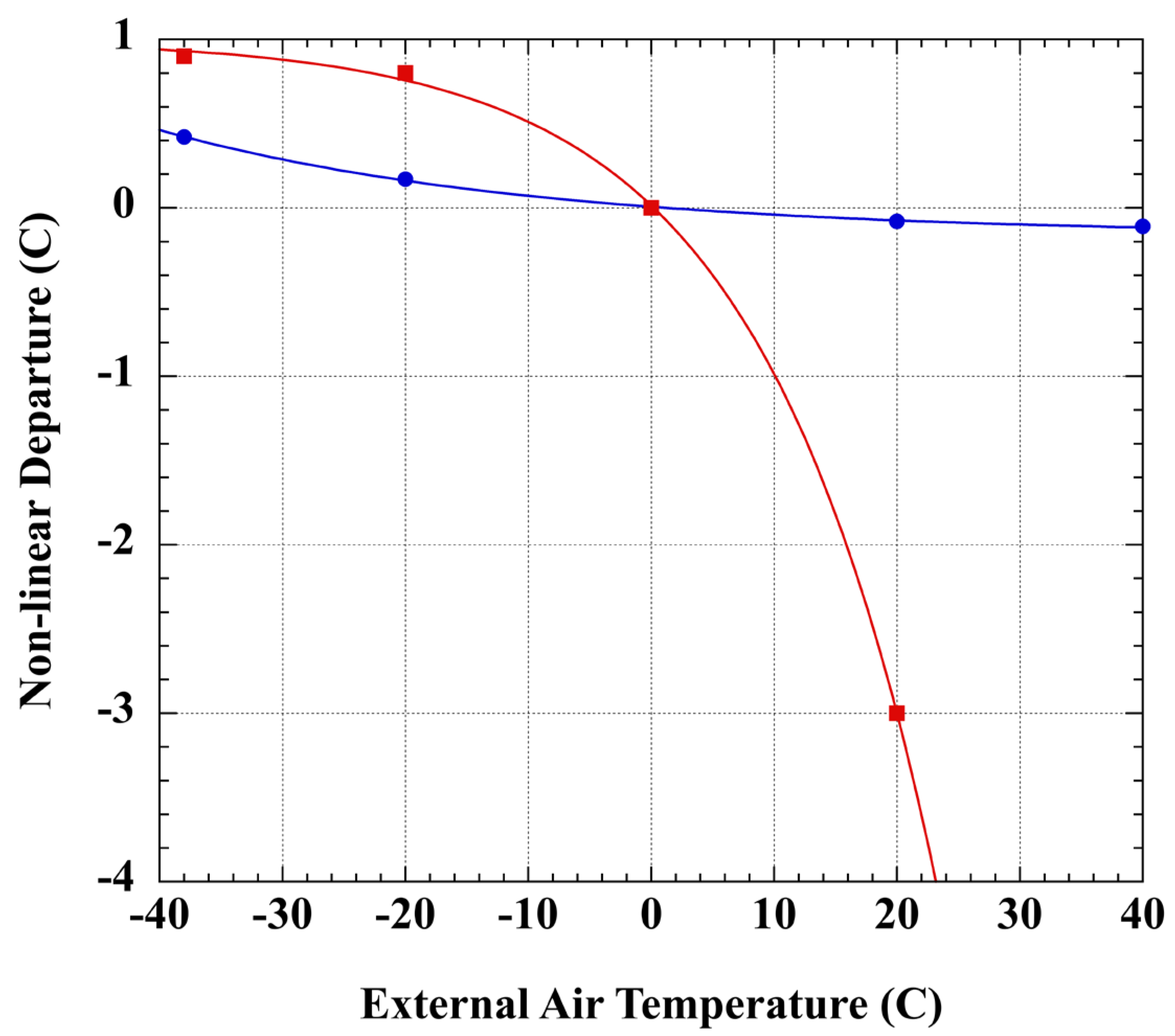
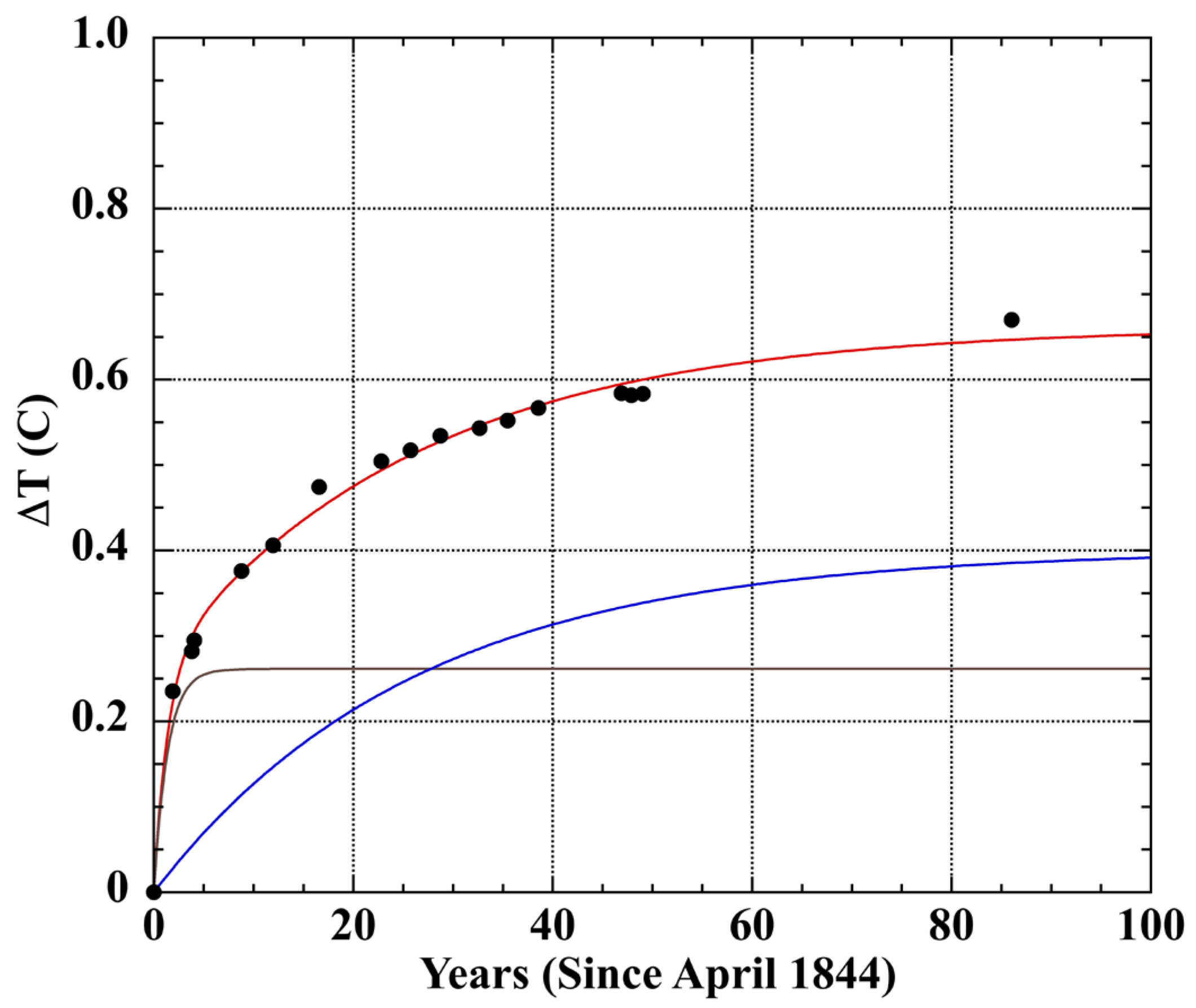

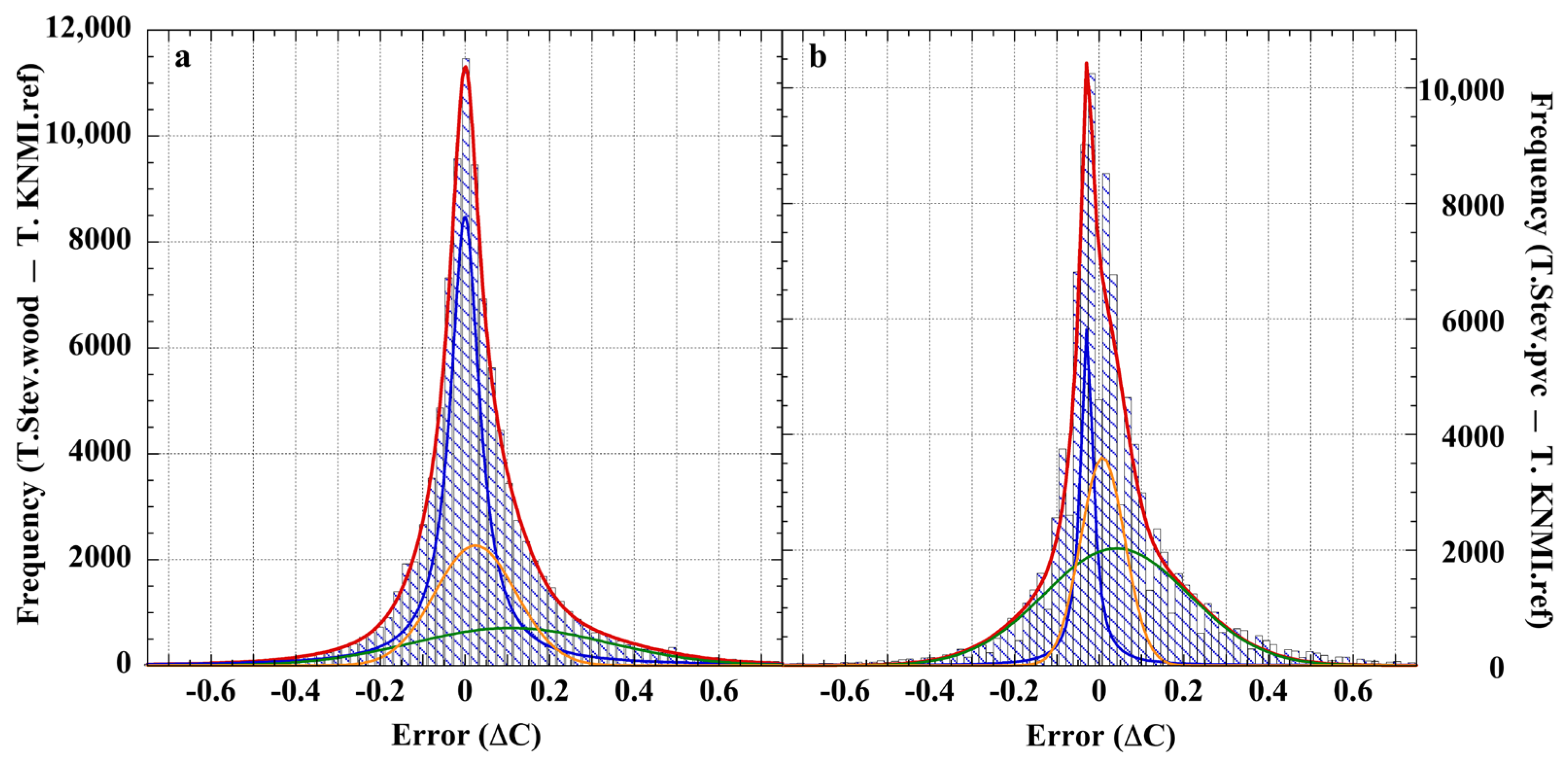
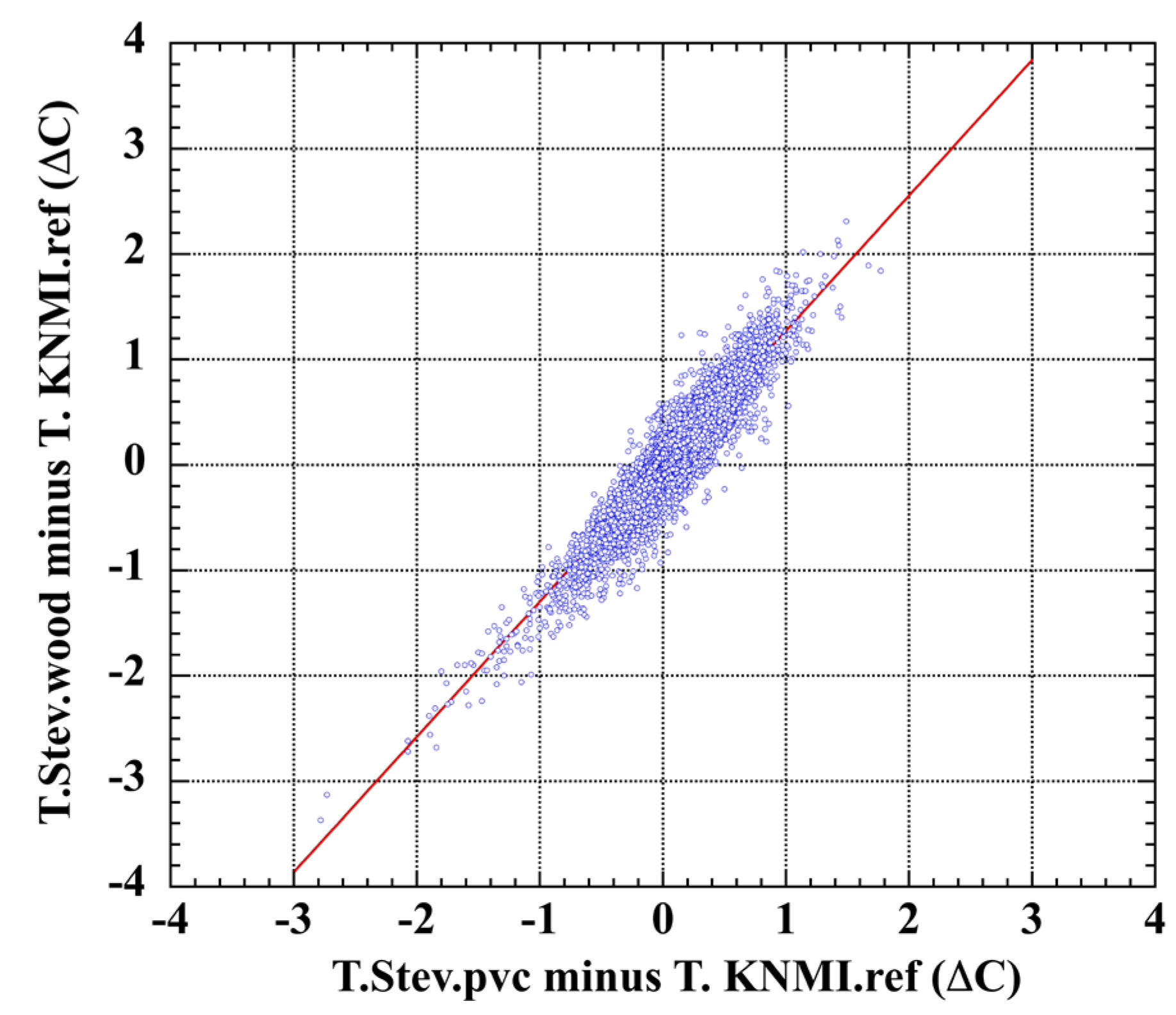
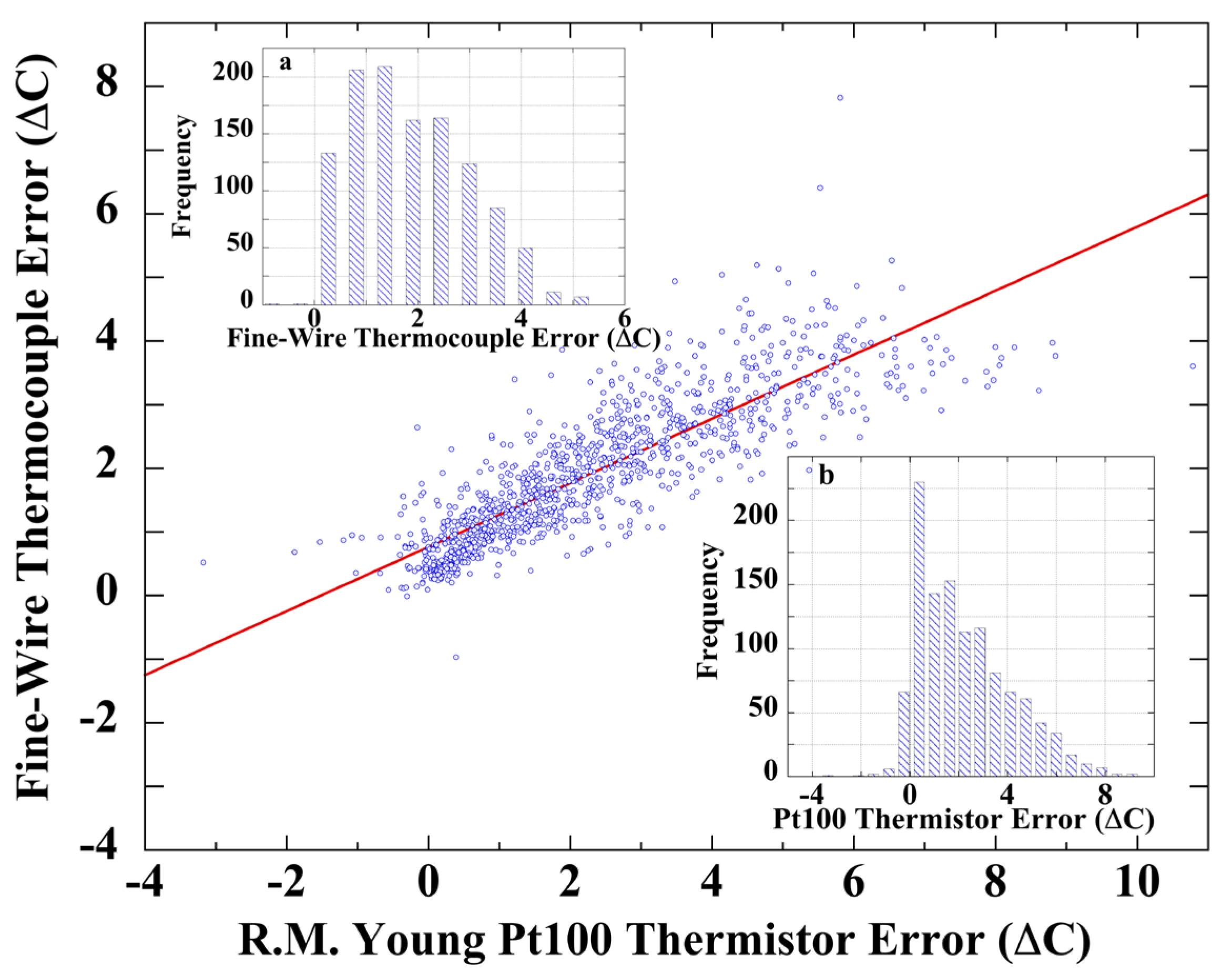


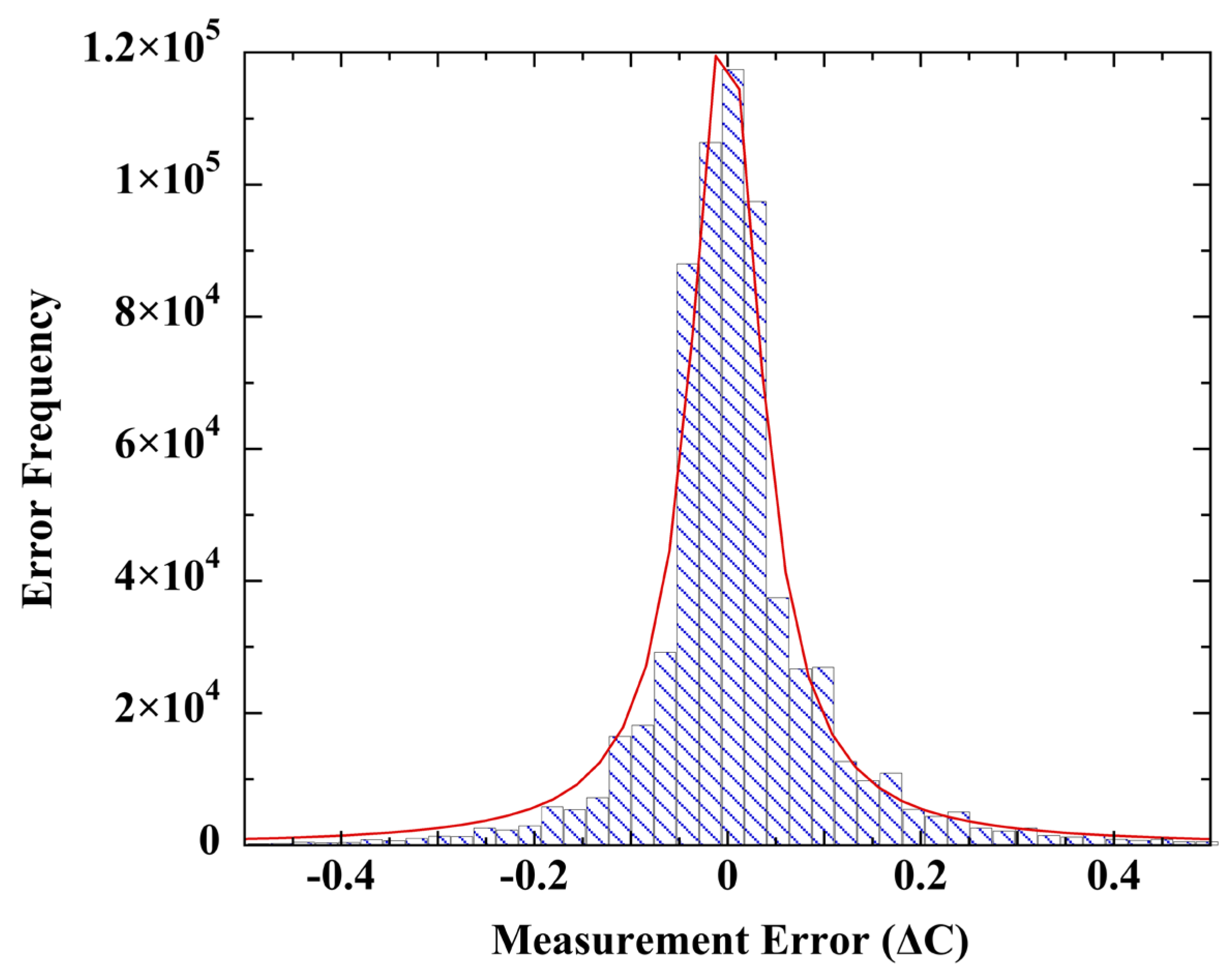
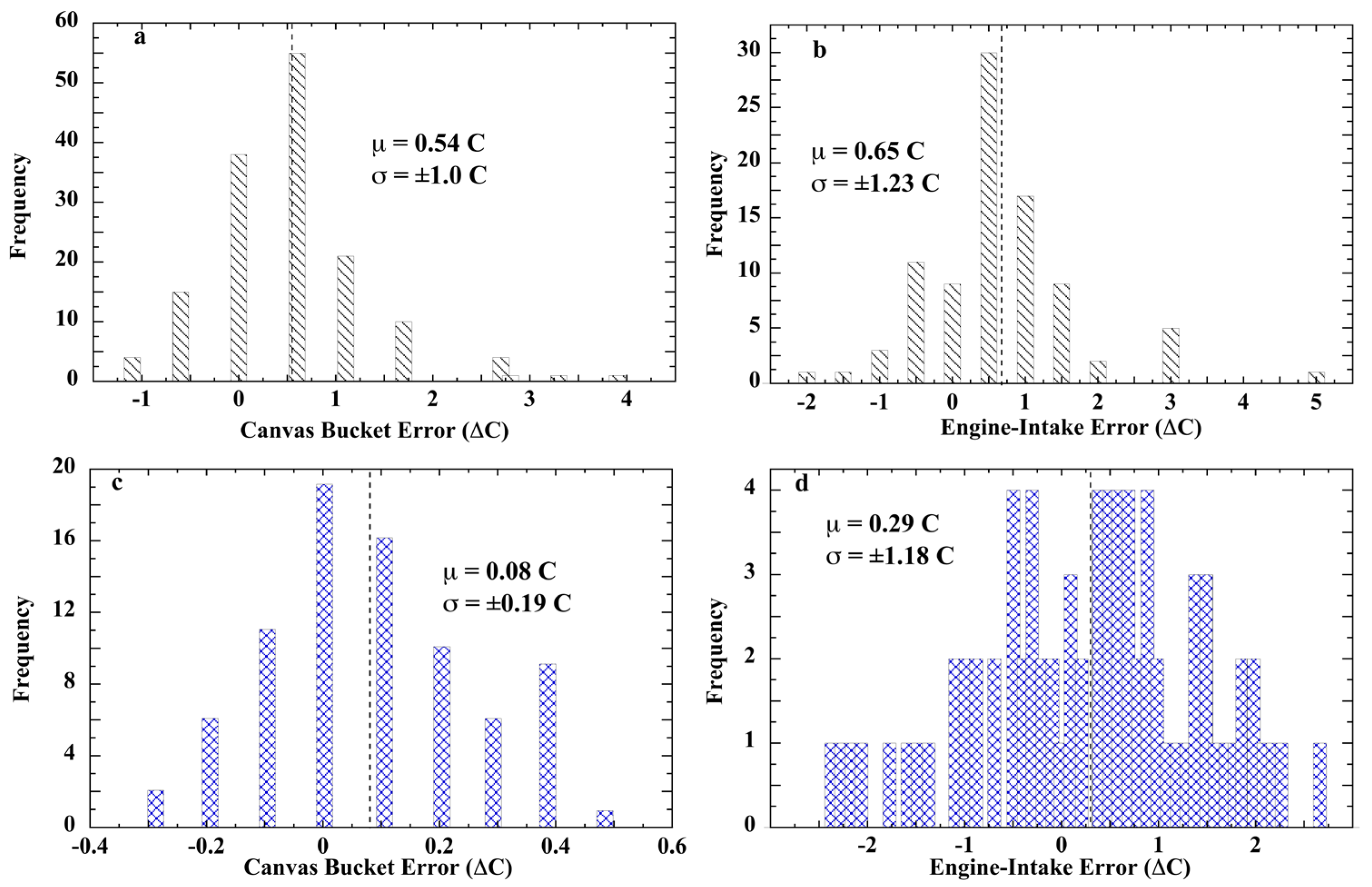

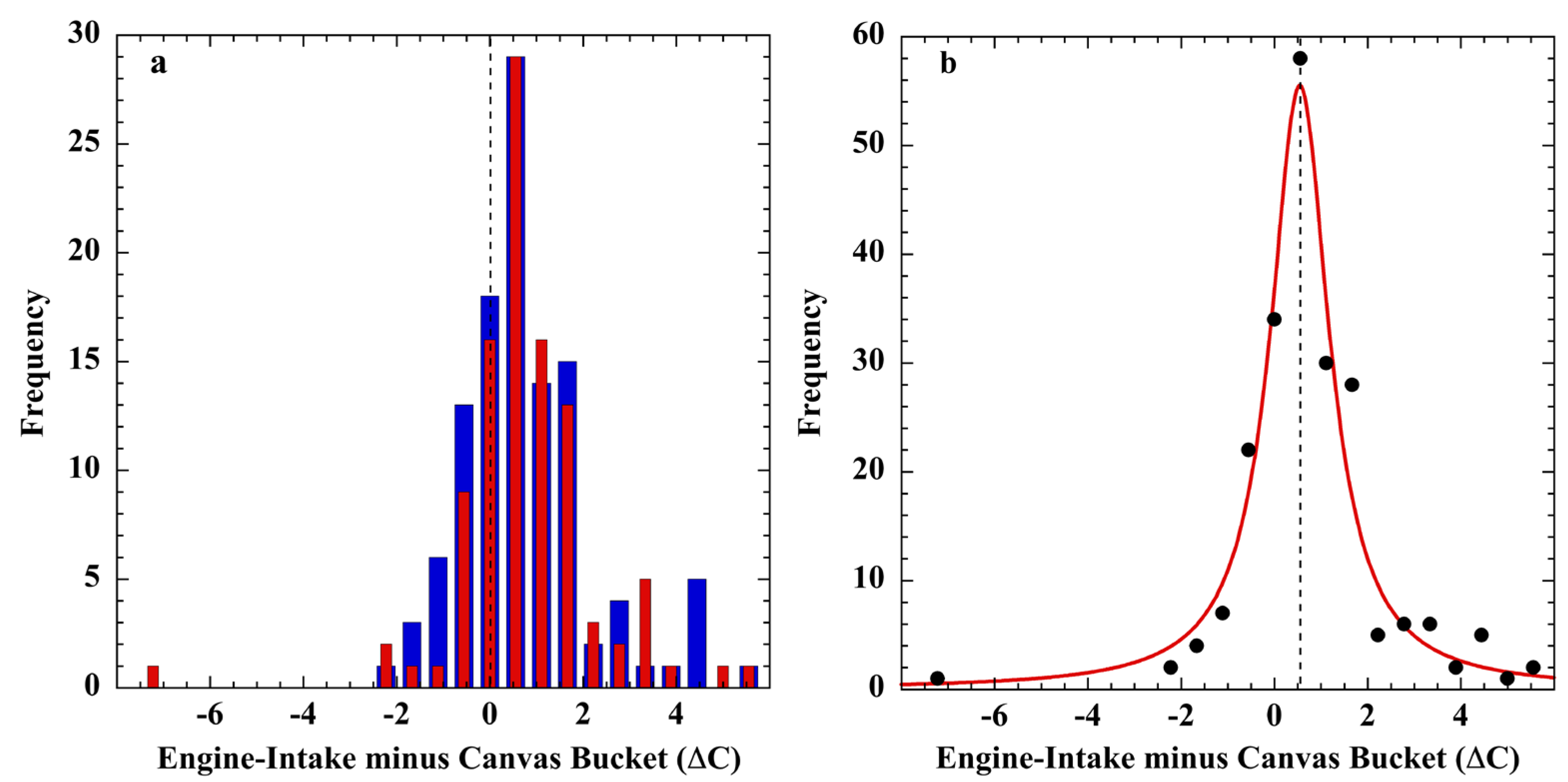

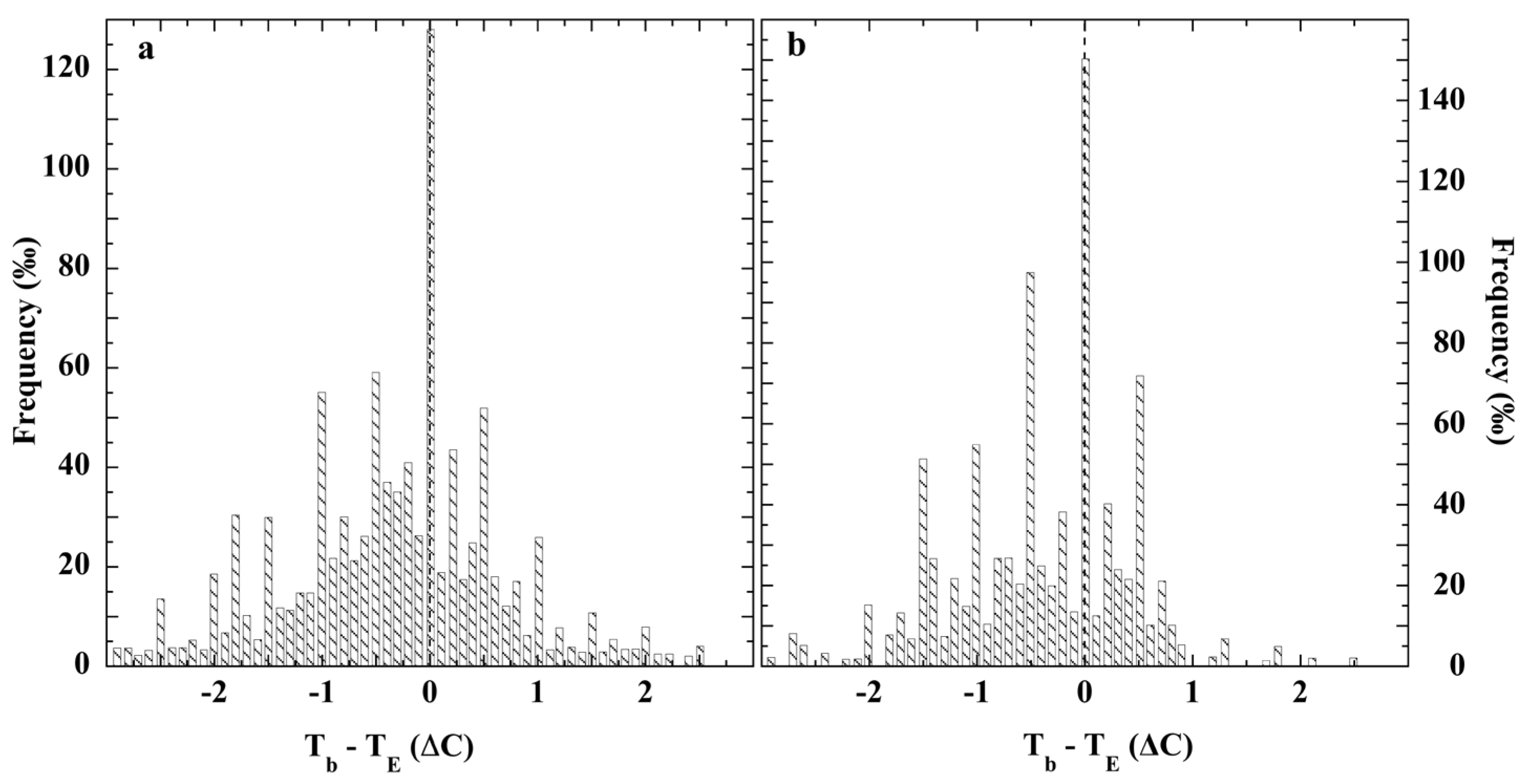
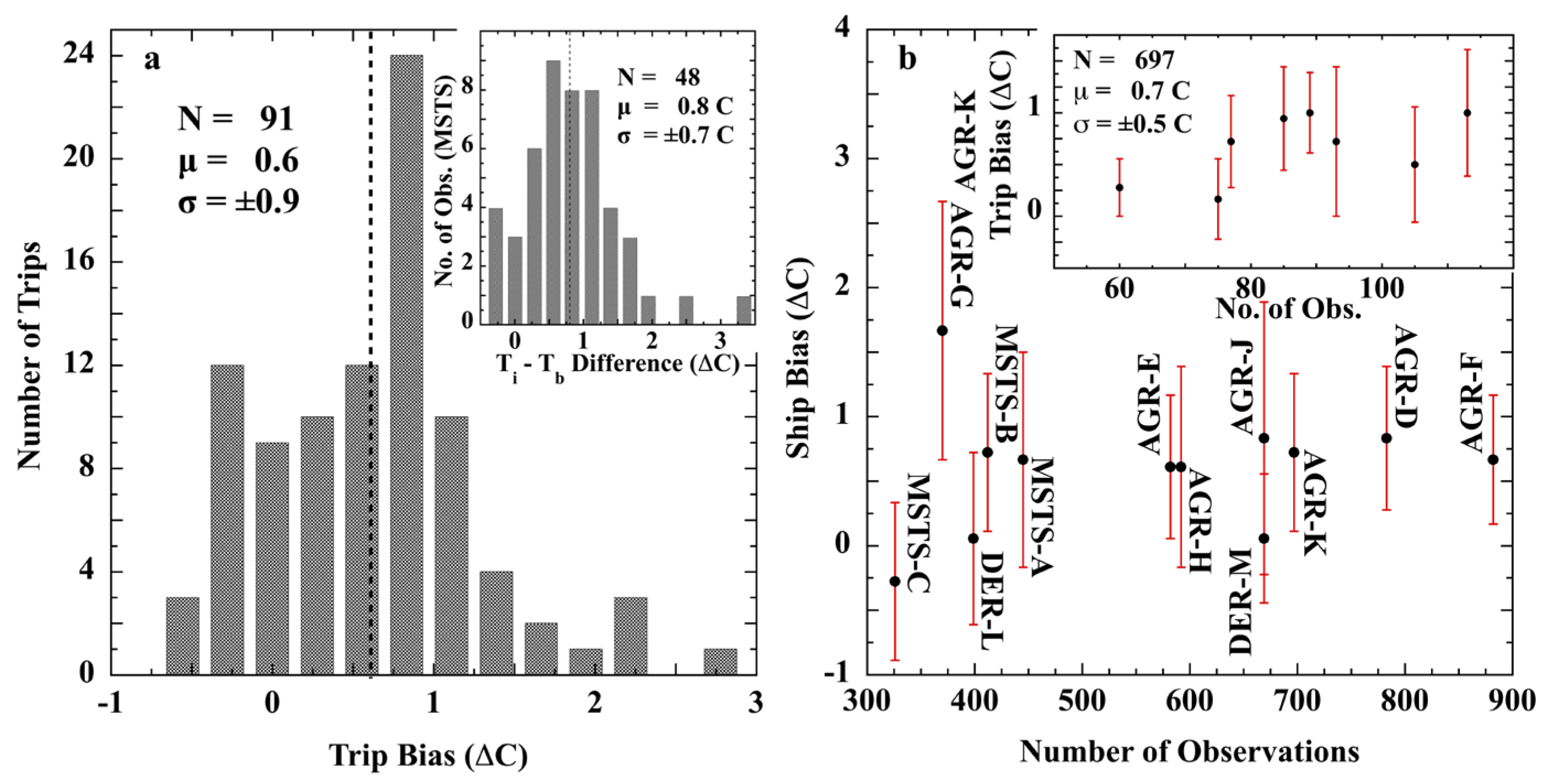
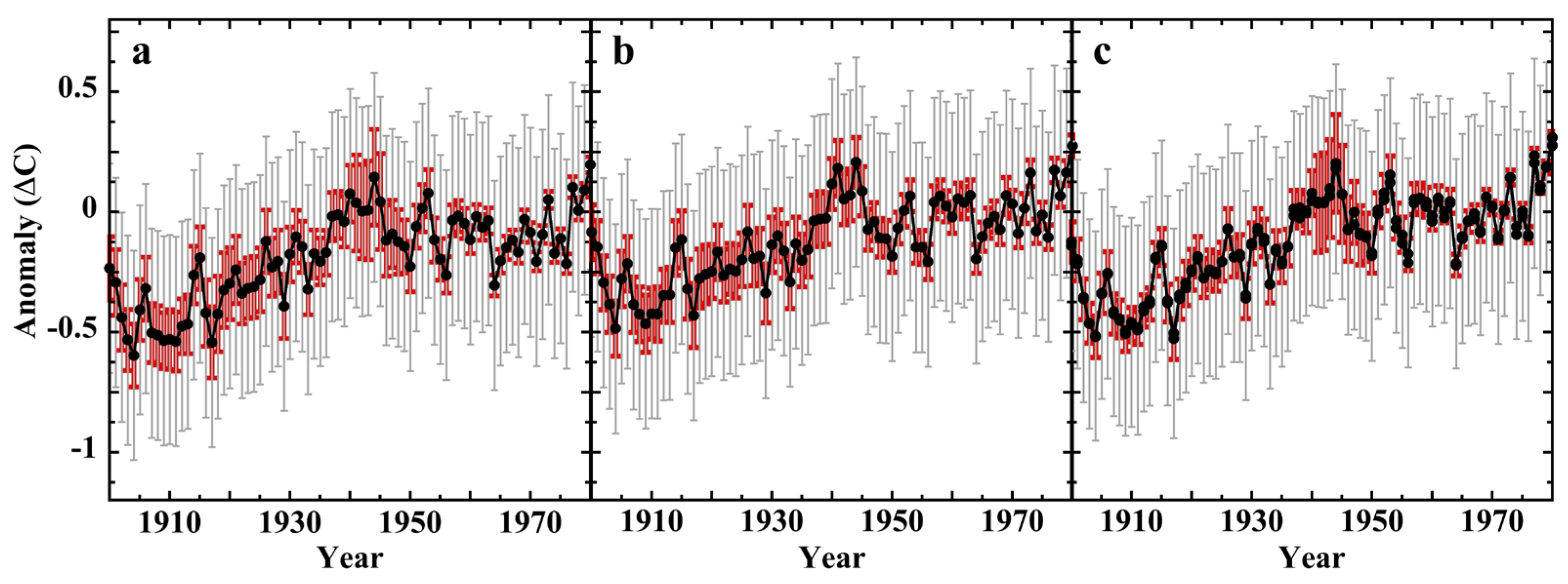
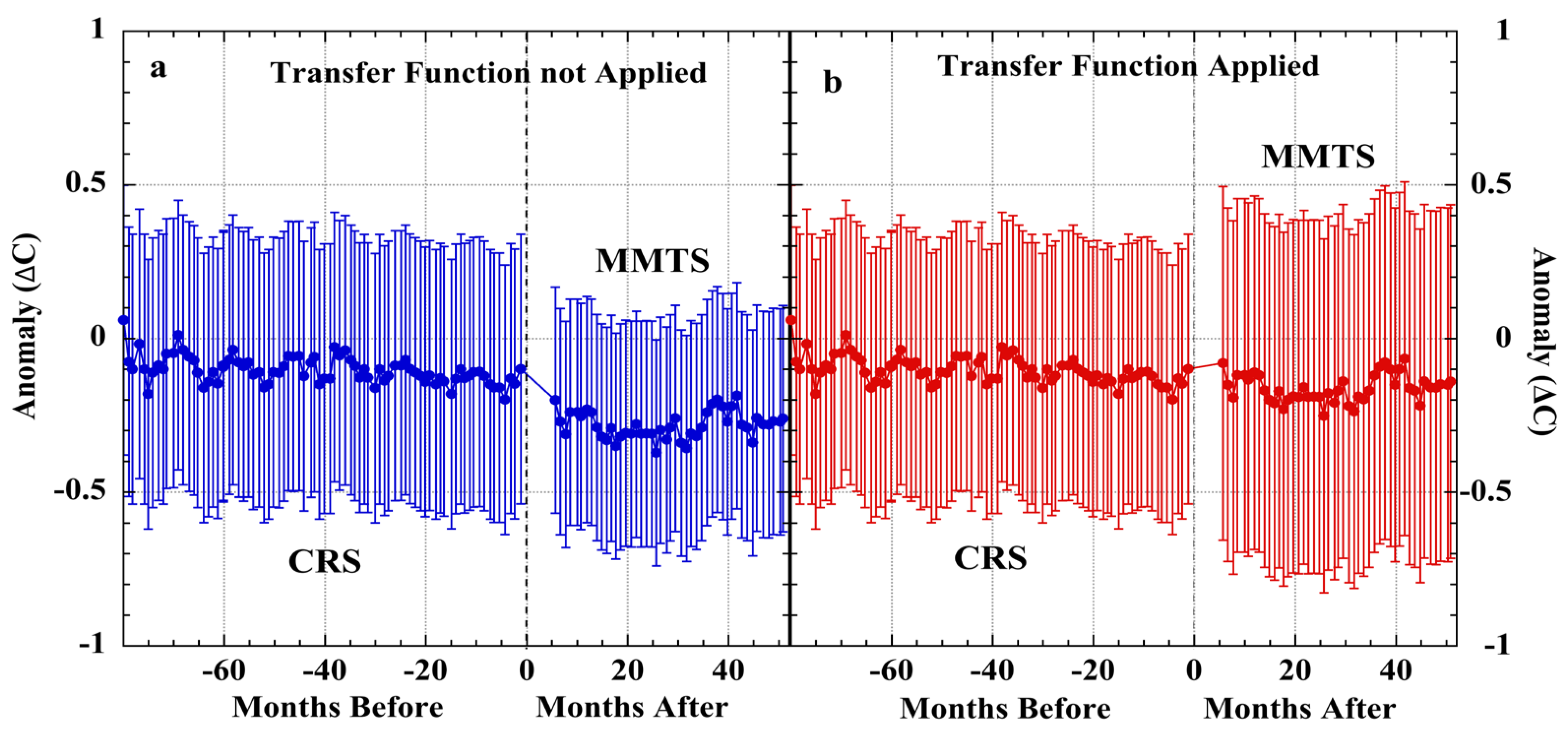
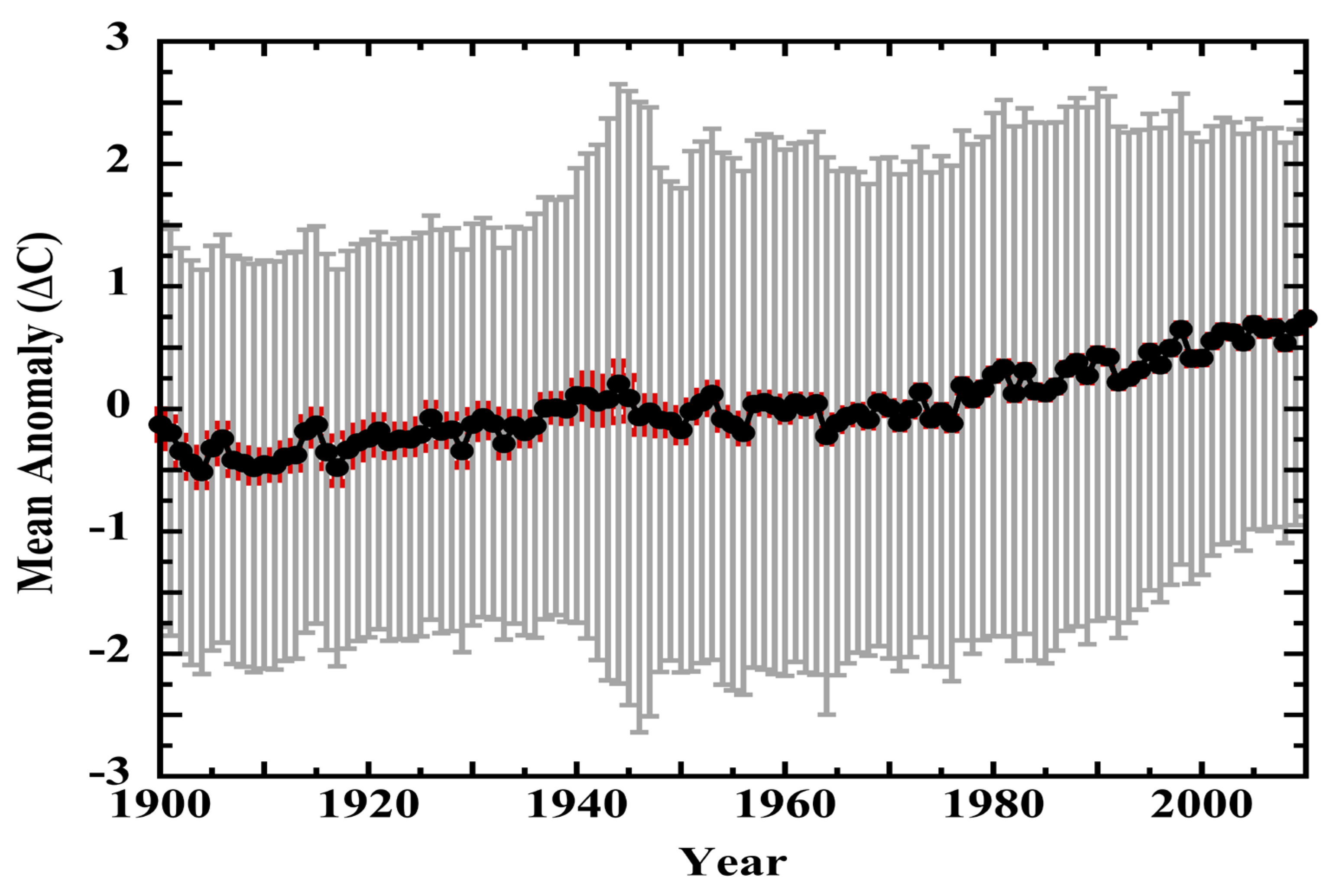
| Eye Alone | Magnifying Lens | |
|---|---|---|
| accuracy limit (resolution) a | 0.300 | 0.114 |
| visual repeatability | 0.144 | 0.144 |
| per-measurement uncertainty b | 0.326 | 0.178 |
| anomaly uncertainty c | 0.461 | 0.252 |
| Gaussian 1 (fm, σ) | Gaussian 2 (fm, σ) | Lorentzian (fm, Γ) | Fit r2 | |
|---|---|---|---|---|
| Stev. (Wood) | 0.108, 0.230 | 0.024, 0.096 | 2 × 10−4, 0.084 | 0.999 |
| Stev. (PVC) | 0.041, 0.172 | 8.3 × 10−3, 0.052 | −0.029, 0.036 | 0.943 |
| Socrima | Young Gill | Stv. PVC | Stv. Wood | Stv. PVC asp | Vaisala | Young asp II | KNMI asp | |
|---|---|---|---|---|---|---|---|---|
| Socrima | 1 | 0.28 | --- | 0.64 | 0.14 | 0.18 | 0.15 | 0.30 |
| Young Gill | 1 | 0.33 | 0.28 | 0.27 | 0.54 | 0.32 | 0.60 | |
| Stv. PVC | 1 | 0.88 | --- | 0.30 | --- | 0.07 | ||
| Stv. Wood | 1 | 0.04 | 0.18 | 0.06 | 0.17 | |||
| Stv. PVC asp | 1 | 0.28 | 0.47 | 0.36 | ||||
| Vaisala | 1 | 0.44 | 0.76 | |||||
| Young asp II | 1 | 0.35 | ||||||
| KNMI asp | 1 |
| Aspirated Ref. → | Thermocouple Yankee 2010 | PRT MetOne 327-C | ||
|---|---|---|---|---|
| Test shield ↓ | Error (µ ± σ; °C) | Shapiro–Wilk | Error (µ ± σ; °C) | Shapiro–Wilk |
| Gill (N = 2072) | 0.11 ± 0.34 | 0.696, p < 0.001 | 0.12 ± 0.45 | 0.968, p < 0.001 |
| Custom (N = 691) | 0.11 ± 0.40 | 0.701, p < 0.001 | 0.12 ± 0.49 | 0.945, p < 0.001 |
| Sensor Shield | Uncertainty (±°C) | Calib. Sensor | Reference |
|---|---|---|---|
| Stv. Wood a | 0.20 | asp. PRT b | [168] |
| Stv. PVC a | 0.19 | asp. PRT | [168] |
| HOBO (25 avg) c | 0.43 | asp. PRT | [90] |
| CRS d | 0.53 | asp. PRT | [31] |
| MMTS e | 0.25 | asp. PRT | [31] |
| MMTS f | 0.28 | asp. thermistor | [32] |
| Gill g | 0.26 | asp. PRT | [31] |
| Gill h | 0.45 | asp. PRT | [171] |
| Custom Plate h | 0.49 | asp. PRT | [171] |
| Gill h | 0.36 | asp. Therm. i | [171] |
| Custom Plate h | 0.40 | asp. Therm. i | [171] |
| Thermocouple k | 2.20 | Sonic Anem. j | [36] |
| R. M. Young k | 2.95 | Sonic Anem. j | [36] |
| MMTS k,l | 0.31 | asp. CRN m | [172] |
| Stv. Wood (lg) | 0.24 | asp. PRT | [68] |
| Stv. Wood (sm) | 0.23 | asp. PRT | [68] |
| Mercury | Spirit |
|---|---|
| 1σnon-linearity = ±0.0138 °C | 1σnon-linearity = ±0.267 °C |
| Land Surface | Sea Surface | ||
|---|---|---|---|
| Instrumental | Instrumental (LiG; 1 °C/division) a | ||
| accuracy (LiG; 1 °C/division) a | 0.30 | accuracy | 0.30 |
| visual repeatability (LiG; 1 °C/division) a | 0.144 | visual repeatability | 0.144 |
| non-linearity (LiG; 1 °C/division) a | 0.371 | non-linearity | 0.017 |
| MMTS b | 0.196 | ||
| Systematic | Systematic | ||
| Stevenson/CRS b | 0.58 | bucket | 0.30 d |
| MMTS b | 0.56 | engine-intake | 2.0 d |
| Instrumental (USCRN) c | bathythermograph | 0.30 e | |
| sensor resolution | 0.10 | ||
| self-heating f | 0.48 | ||
| Normal Period | Anomaly Mean (Δ°C) a | RMS 2σ Uncertainty (±°C) | 100-Year Trend (Δ°C) a |
|---|---|---|---|
| 1901–1930 | −0.30 | 0.71 | 0.79 |
| 1911–1940 | −0.20 | 0.73 | 1.23 |
| 1921–1950 | −0.09 | 1.15 | 0.74 |
| 1931–1960 | −0.03 | 1.41 | 0.26 |
| 1941–1970 | −0.91 | 1.57 | −0.31 |
| 1951–1980 | 0.0 | 1.48 | 0.40 |
| 1961–1990 | 0.09 | 1.49 | 1.50 |
| 1971–2000 | 0.24 | 1.44 | 1.82 |
| 1981–2010 | 0.43 | 1.26 | 0.0 |
Disclaimer/Publisher’s Note: The statements, opinions and data contained in all publications are solely those of the individual author(s) and contributor(s) and not of MDPI and/or the editor(s). MDPI and/or the editor(s) disclaim responsibility for any injury to people or property resulting from any ideas, methods, instructions or products referred to in the content. |
© 2023 by the author. Licensee MDPI, Basel, Switzerland. This article is an open access article distributed under the terms and conditions of the Creative Commons Attribution (CC BY) license (https://creativecommons.org/licenses/by/4.0/).
Share and Cite
Frank, P. LiG Metrology, Correlated Error, and the Integrity of the Global Surface Air-Temperature Record. Sensors 2023, 23, 5976. https://doi.org/10.3390/s23135976
Frank P. LiG Metrology, Correlated Error, and the Integrity of the Global Surface Air-Temperature Record. Sensors. 2023; 23(13):5976. https://doi.org/10.3390/s23135976
Chicago/Turabian StyleFrank, Patrick. 2023. "LiG Metrology, Correlated Error, and the Integrity of the Global Surface Air-Temperature Record" Sensors 23, no. 13: 5976. https://doi.org/10.3390/s23135976
APA StyleFrank, P. (2023). LiG Metrology, Correlated Error, and the Integrity of the Global Surface Air-Temperature Record. Sensors, 23(13), 5976. https://doi.org/10.3390/s23135976





